-
Posts
905 -
Joined
-
Last visited
Content Type
Profiles
Forums
Gallery
Events
Posts posted by shipmodel
-
-
Hi all -
Yes, an interesting project that is open to some speculation. Although there is no definitive information on the ship's appearance, we can reason backward from what is known.
A researcher on the project has combed through the French archives and in his 159 page report he convincingly demonstrates that she was built as La Concorde for a private commercial firm, rather than for the French navy. She is described as being one of the light frigates of 250 to 300 tons, which fits well with other such ships being built for the navy, so her design was probably quite similar. Budriot, in his major work, "The History of the French Frigate, 1650-1850" has a short chapter on these light frigates with illustrations of several of the naval frigates as well as lines drawings and artistic illustrations such as the one that I included. There is even a lengthy written description of a "Light frigate armed with 20 6-pounders" which is exactly what the Queen Anne's Revenge was. I am still working through the dense prose to glean bits of useful information.
However, she was not built for the navy, but for a private firm. As such, she would not have had the elaborate carvings, paint and decorations that a national warship would have carried and which Budriot puts on Le Mercure.. Even if there were originally some touches of color, by the time she finished a privateering cruise and two slaving trips some seven years later I do not believe that any would have remained.
We are on surer ground with the rig. Masts and spars were pretty well standardized by 1710 for the size of the ship. Budriot provides a detailed drawing of all of the sticks and fittings in the Mercure drawings, which will be checked against Lees, Petrejus and other writers. But that is for later - much later.
Till then, be well.
Dan
-
Hi all -
If you want to follow my next build, I have started a log for the Queen Anne's Revenge in the scratch-built forum. I do not have the direct link, but it should be easy to find.
Looking forward to all of your comments and suggestions for improvements.
Dan
-
Hello to all -
Those of you who followed my building of the Swan 42 racing yacht may experience some temporal whiplash as the Wayback Machine moves the shipyard some 300 years into the past. Even though the scale will be about the same, the materials, methods, and style will have little or nothing in common with the last project. We leave the clean lines and millimeter accuracy of a rich man's toy for the rough outlines and incomplete draughts of a pre-Colonial pirate ship.
Queen Anne's Revenge was the flagship of the notorious pirate Edward Thatch (incorrectly called Teach), known as Blackbeard. In barely more than a year and a half, from the summer of 1717 to November 22, 1818, he and two other pirate leaders put together a large fleet that took numerous merchant ships, looting them and holding any worthwhile captives for ransom while taking any willing sailors into his piratical crew. He was hardly the most notorious or bloodthirsty pirate, but he captured the popular imagination with his large fierce black beard and his habit of placing lit rope matches for his weapons into his hair during a battle.
The origins of the ship herself are not definitively known. It is thought that she was built in about 1710 as a small frigate of about 300 tons known as La Concorde, with her first cruise as a French privateer during Queen Anne's War in 1711. When the war ended in 1713 with the Treaty of Utrecht her owners sent her into the slave trade. She made two profitable cruises between 1713 and 1717, taking slaves from West Africa to the French colonies in the Carribean and capturing prizes on the return leg back to France. On November 28, 1717, during her third slaving cruise, she fell afoul of Blackbeard with two armed sloops. Her crew was sick and many of the cannon had been removed to make more room for slaves so she was captured easily. Below is a drawing of a similar light frigate from the early 1700s.
After renaming her Queen Anne's Revenge and adding significantly more cannon, she became Blackbeard's flagship and was used to capture numerous ships and even to blockade the port of Charleston for a week. Turning north from there in company with several smaller pirate ships on June 10, 1718 they tried to enter a shallow anchorage known as Topsail Inlet (or Old Topsail Inlet), now called Beaufort Inlet in North Carolina. Although several other ships entered safely, the larger Queen Anne's Revenge grounded on the sand bar at the entrance, as did another ship that came to her aid. After removing the valuables she was abandoned and left to the cruel mercies of the sea. Blackbeard himself lasted barely another six months until his death in November of 1718 during a battle with the Royal Navy.
The ship was rediscovered in 1996 and is now being excavated underwater in project managed by the North Carolina Department of Cultural Affairs and the North Carolina Maritime Museum, part of East Carolina University. Numerous artifacts, including several cannon, coins, navigational equipment, and hundreds of everyday items have been recovered and are being conserved. You can see photographs of the artifacts, view interactive maps of the ship's history and the wreck site, and read the archaeologists' and researchers' detailed reports if you go to the Queen Anne's Revenge website at http://www.qaronline.org/Home.aspx It is a little gem of a site and well worth looking into.
I have been asked to build two display models of the QAR for the Maritime Museum. They will be at the large scale of 1:36, yielding a model of some 48" LOA from the tip of the jib boom to the ensign staff at the stern. It will rise some 44" from the keel to the main truck with a main yard of some 22" with stunsail booms rigged but not extended. The hull is to be solid below the gun deck but open and fully detailed above. She is to have a full suit of sails with all sail handling lines, although several will be furled so the deck can be more easily viewed.
There are no plans or illustrations of the ship, so her apearance is a bit conjectural. As a basis for the model I have been given two sets of plans. The first is a simple, one-page rendering of the lines and profile of a similar small French frigate which was captured by HMS Advice and which is known therefore as Advice Prize.
I am also working from a set of drawings done by Jean Budriot of yet another light French frigate of the period known as Le Mercure. He has written a monograph that is illustrated with numerous detailed drawings of all of the bits and pieces of the ship including several profiles, cross-sections and longitudinal sections, and sail and rigging plans. However, as is his custom, there is no station lines plan from which to derive the hull shape.
These two sets of plans have to be reconciled, not only with each other, but with the known historic facts. For example, it was reported in contemporary accounts and court-martial testimony that the Queen Anne's Revenge had 20 large cannon on board when she went down. Le Mercure is pierced for 10 guns on each side, but the Advice Prize has only 9. The Mercure drawings have the channels for the fore and main shrouds set below the gunports, while the Advice Prize has them above. Le Mercure is shown with a square, open beakhead bulkhead, while the plans for the Advice Prize shows a closed in forecastle. At the stern Le Mercure has a large quarter gallery, rather than the small quarter badge of the Advice Prize. But that quarter badge is set very high, with an indication that the Advice Prize had a poop deck above the quarterdeck. These and many other details, large and small, will have to be reconciled as construction continues.
To begin with, a tenth gunport was added to the Advice Prize and their spacing was adjusted accordingly. The quarter badge was lowered and it is this resulting profile that will be used to build the models.
On this plan you can see a horizontal red line. This is my line of demarcation between the solid hull below and the open gundeck above. It is set at the level of the gundeck for the forward four ports. A tapered piece will be added at the rear half of the ship to account for the sheer rise of the gundeck towards the stern. But this line is also used as my registration plane for setting up the templates for the hull shape at the various stations shown on the plans.
As I was working out the hull construction the first of what will surely be many problems arose. In the scale that is required, the maximum breadth of the model works out to just over 9 inches and the station lines work out to, mostly, 3 inches separation. To work from the centerline I would need wood of at least 4.5 inches wide and 3 inches thick. However, wood of that size is not easily or inexpensively acquired. Instead, I found basswood planks 4 inches wide and up to 2 inches thick. I decided therefore to piece together the hull.
As you can see in the wood blocking plan below, I started with a vertical central piece 3/8" thick to match the width of the keel. This was sandwiched on each side by a vertical lift 1/2 inch thick, then by the side pieces whch would be cut to the profiles of the appropriate station lines from the plans.
As usual with vertical station line lifts, they were cut to the profile of the appropriate station line. For each three inch station segment a two inch lift and a one inch lift were used. I also decided that the hull should be partially hollow, not only to reduce weight, but to give the stresses somewhere to go other than outward when the wood swelled with changing humidity. My solution was to take each lift and cut out the center, leaving a crescent of wood about 1 inch thick. Construction began with the gunport deck piece cut to shape and the three vertical central pieces glued to it using carpenters' squares for alignment. Then the station line lift crescents were glued in place and secured with dowels. Here you can see the first three segments glued and pinned, with the fourth made ready for installation.
This was continued from the center out to the bow and stern, with the final lifts left solid and clamped to the growing hull block. The completed hull block was left to dry for a week before the bamboo dowels were trimmed off.
Now the carving and shaping had to begin to reduce the stepped shape of the lifts. The model is so large that the usual woodworking tools were inadequate in any reasonable time frame. I therefore purchased an angle grinder and set it up with coarse 50 grit sanding discs. This was followed by a random orbit sander, also with coarse grit paper.
As you can imagine, this makes a hellish racket and leaves a hellish mess, Eye, ear and respiration protection are a must, and if you are not going to do all of it outside, you need three other things - an empty room in the basement; a big shop vacuum; and most importantly, an understanding wife. I am glad to say that I have the first two and am blessed with the third.
In this photo you can see how far the shaping has progressed. From here there still has to be a lot of hand work that is checked and rechecked as usual with station line templates. The next segment will take us through that process.
Be well
Dan
-
Thank you all for your compliments. Peter and I have been very gratified by the responses, both from you and from the owners. In fact, I received two inquiries about models for individual owners. With 55 boat owners out there, this could become a cottage industry for me in my dotage - as if I am not there already . . . :-))
Be well
Dan
-
Hello, all –
My name is Peter. Dan is working in the shipyard so he asked me to give you a tour of the completed Swan 42. As you can see, I brought with me the world’s largest dime for a bit of size comparison. Since the last segment of this build log we have installed all of the various pieces and subassemblies that were created before, set up the mast, boom and rigging, and installed her on a custom made presentation base ready for delivery.
So let me show you around, from bow to stern and bottom to top. Here she is, neatly balanced on her keel bulb. You can see just how tall her rig is. The laminated wood mast rises 62 scale feet from the deck, some 20 feet longer than the hull itself. The spreaders which set up the shrouds are of different lengths and are set at different angles to the mast and to vertical. They are cut from brass sheet, given a layer of epoxy and then faired to their aerodynamic shapes. The standing rigging is 0.012” stainless steel beading wire, which is too small to see in this photo, but will show up later.
Here is a view of the entire deck. If Dan did his job well there should be nothing that draws the eye and disrupts the overall impression of being aboard the actual boat. He always says that it has to obey the Rule of 3 – it has to look good from across the room, with detail work that makes you want to see it much closer. Then it has to look good from 3 feet away, like the point of view of this photo, with new and interesting details to see. And then it has to look right from 6 inches away, with even more details that create the ‘texture’ of the actual boat.
Of course, the hull and deck have to be symmetrical, so we checked it repeatedly as the mast was being installed. Here is how it came out, viewed from the middle distance.
Now let’s move in to the 6 inch viewpoint and look around. At the bow is the pulpit. Dan has explained how this is made from brass tubes that are assembled, soldered and electroplated in chrome. Now it is installed with small feet at the end of each leg made from chrome foil. The jibstay is made up from beading wire with a sleeve of insulation taken from black speaker wire. The furling fittings at top and bottom are simply made up from a short piece of tubing and punched discs as caps. The railing is 0.009” silver beading wire which is turned back on itself and seized with black fly tying thread. The lacing is also fly tying thread, which is looped over the top rail and then goes through some tiny eyebolts set into the deck.
The railing stanchions are turned and tapered brass rods with holes drilled for the railings. The support bar is a thinner brass rod soldered to the upright and bent to shape. The base, feet and other fittings are chrome foil. The turnbuckles are made up from sections of 0.04” brass tube that surround and secure the beading wire shrouds to a pair of large deck eyebolts. All of the brass is electroplated like the pulpit.
Amidships is the mast, boom and boom support arm (vang?). The running rigging is color coded so that during a race there is no confusion or delay in identifying the right line to haul. The halyards travel mostly inside the mast tube, then emerge not very far above the boom, run down to single blocks at the foot of the mast, through a wide flat tunnel under the cabin roof, up and through the line clutches and then to the winch. Here they are displayed as if for dockside presentation at a regatta.
The boom is laminated wood, attached to the mast with a hinged and pivoting fitting of machined brass pieces. The arm is constructed from three pieces of telescoping brass tubing with a double block slung underneath on a brass crescent fitting. The pink vang line runs from the port side camcleat near the aft cabin handrail to a single block secured to the deck, then through a single block on a strap tied to the lower hinge fitting for the boom arm, back and forth between the upper triple block and lower double block (note how the line switches from under/over the triple block to over/under during its second pass), then out a matching set of single blocks and camcleat on the starboard side. All of this is just to get the purchase to haul on the large single block whose line reeves through several pulleys inside the boom arm. The mechanical advantage of this setup must be immense.
Much of the rest of the deck details have been shown before, but here they are all installed.
The wheel pedestals are set at a 10 degree angle to vertical. The main sheet traveler track and car are rigged for use with the main sheet running up to blocks attached to the fore and aft ends of the boom. At the extreme aft end of the deck is the hydraulic tensioner for the backstay. Again, this is telescoping brass tube and rod, securing the backstay which is heavier beading wire painted to simulate the Kevlar coating.
Below the waterline is the keel fin, keel bulb, and rudder. All are carved from basswood, sealed and painted. Between them is the small propeller for powered maneuvering in port. The blades of the prop close like a clamshell when not in use and stay most of the time in this streamlined configuration.
Finally, at the very top of the mast are the instruments that read wind direction and speed. This data, along with that from other sensors, is displayed on a series of screens mounted on the mast below the boom that you can see in other photos.
So there she is, completed and mounted. Here are a few overall photos. It has received some critical praise from owners of the actual boats and hopefully will be accepted for display in the Model Room of the New York Yacht Club.
The shipyard is now moving back in time 300 years from 2005 to 1705 to build the Queen Anne’s Revenge, a 20-gun light frigate that was the flagship of the pirate Edward Teach, known as Blackbeard. It is being excavated underwater at Beaufort Inlet in North Carolina. Go to http://www.qaronline.org/History/TheShipwreck.aspx Look for a build log here in the future.
- PierreJean, mtaylor, GrandpaPhil and 6 others
-
 9
9
-
Hi Clare -
No need to fake the elevating screw mountings. You obviously have the skills to drill the holes in the cascabels. For my Swan 42' model I had to drill 0.012" holes through 0.040" brass rod. Here is how I did it - maybe it will work for you.
First, cobble up a simple wooden board with glued on battens that will snugly hold the cannon barrels (see photo below). Chuck a high speed drill bitt into a Dremel. Start with one that is smaller than you want the final hole to be. Check that the bitt spins exactly on its axis and does not wobble. If it does, rechuck it in another spot.
Dip the end of the bitt into household oil. Holding the barrel firmly in its jig, bring the drill bitt into contact with the metal where you want the hole to start and make a small depression. Re-oil the bitt (do this at regular intervals and any time the bitt seems to be working too hard). Take your time and back the bitt out occasionally. I did not have to go through much metal, so I did it with a hand-held Dremel, but you could do it with your Sherline or a Dremel drill press.
Once the first hole is made you can expand it to final size with a large bitt. This hole should go much faster and easier than the first. Now you can feed a miniature screw rod through it to make a very realistic elevating screw.
Hope this helps.
Dan
-
Hi all -
Hope the summer is being good to you.
Now that the complex railing pieces at the bow and stern are done, I turned to the allegedly simpler deck edge stanchions. They are two feet (scale 3/4") tall, tapered towards the top, and have two through holes for wire railings. Six of the ten have side supports. All have a triangular base piece and a collar at the base.
These were initially made from 0.062 brass tube, with the supports from 0.03 rod. Each was cut off to length and the two railing holes were drilled with a 0.0012 (#80) drill. I found this easiest to do with the piece in a simple jig that held it in place with the locations of the holes marked out. I first tried to do the drilling in a miniature drill press, but the bitt kept skipping off the curved surface. Ultimately, I did it by eye, with the drill bitt in a cordless Dremel. Lots of light and magnification are essential. A drop of oil makes the drill cut much more efficiently. After the railing holes were made at locations marked on the jig, the stanchion was turned 90 degrees and a loose drill bitt inserted through the top hole. This held the stanchion in the jig so the 0.020 hole for the support could be drilled perpendicular to the railing holes. With all the holes drilled the stanchion was chucked into a Dremel and the top quarter was tapered to match the boat photo. A full set of ten was made and electroplated.
The customer wanted some progress photos, so I temporarily mounted the railings on pegs into the deck. The railings were strung on the starboard side using 0.0095 beading wire. The diagonal lacing at the bow is fly tying line, nominally 0.0030 diameter, although the cross section is not actually round. Here is how it came out.
The more I looked at it, however, the less I was satisfied. 0.062 scales out to two inches, which is very close to the actual diameter, but on the model the optical illusion effects made them too heavy. A bit over a day of extra work and another set was made from 0.045 rod and 0.020 supports. Here you can see the difference.
And here is how the redone stanchion looks. Note the other small deck details - the padeye at the base of the support, the scammell on deck and the cam-cleat with the red tops on the posts.
The next item is the most complex miniature assembly on the model. The main sheet traveller consists of a large block mounted on a car that runs on a track athwart the cockpit with rigging to pull it side to side. It holds down the end of the boom while still allowing it to move from port to starboard. Here you can see one in use on a boat on the water.
Here is a picture of the car from the Harken catalog. It consists of a base that rides on the track, three small sheaves on each side and a camcleat on each end, with the large block hooked to an eye in the center. It is just over 9 inches long.
Here is the final one for the model. At just over 1/4 inch long it contains 24 parts. These include 1/16 inch diameter punched plastic sheaves, chrome foil base and retaining straps, and camcleats made from 0.025 styrene rod. The spaces around the sheaves are clear to permit the run of rigging.
And here it is installed in the cockpit with the rigging running out to double blocks set horizontally at either end.
Here is what it will look like when the steering wheels are installed. This was set up as a check to compare to the photos of the actual boats.
Now the rest of the small deck details were made and installed. Here is the jib sheet traveller. It is much like the main sheet traveller, but smaller and less complex, although its rigging is more complicated and involves several sister blocks that were made by pinching in the waist of a cast Britannia block from Bluejacket. I settled on these blocks as they are the correct size, strong, and reasonably accurate. A little cleanup, some adjusting and detailing and they are impossible to tell from the actual ones at this size and scale.
So here it is, set up on its temporary mounting. Next time we move to the boom, its support arm, and the rigging. I think I see the light at the end of the tunnel, and just hope that it is not a train coming at me.
Be well
Dan
- Wishmaster, mtaylor, Ryland Craze and 1 other
-
 4
4
-
Hi all -
Thanks, as always, for the compliments. It is coming along slowly but well, I think. The past several weeks have included the July 4th long holiday and the move of my son and his family from Brooklyn to Michigan, which took me away for some time from the construction yard.
Mostly I worked on the railing fixtures at the bow and stern. These are not only complicated three dimensional metal pieces, but require detail soldering and electroplating. Many almost completed, or even fully completed iterations were discarded before acceptable ones were fashioned. Without dwelling too much on past mistakes, here is how it went -
The fixture at the bow consists of a top bar that bends around the bow and then bends down to becomes the aft two of the four angled legs that support it. The pair of legs on each side is connected by a low bar as well. Here is what it looks like on the boat.
The plans provided gave only a profile view, but I found a detailed deck fitting drawing which shows the plan view.
Similarly, the stern fitting has a top bar that bends at almost a right angle around the corner of the transom and becomes a short foreleg and a much longer transom leg, with a vertical piece and horizontal pieces connecting everything together. Here it is on a boat
And here from the plans and drawing
To match the dimensions, I used brass tubing of 1mm o.d. and internal diameter of 0.020". I could have used solid bar stock, but using tubing provided a lot of advantages during construction. Here is the setup for the bow fixture, surrounded by my soldering tools and supplies.
I do most of my soldering with this inexpensive "Cold Heat" device that I heard about through an infomercial on TV several years ago. This is the first time that I am using it for a commissioned model. It is a battery powered resistance soldering unit made for the miniatures or jewelry market. It works by passing an electric current between two carbide electrodes set in a "cloven hoof" configuration with a small gap between the electrodes. When both tips contact metal the current flows between them, heating the metal by induction, or resistance in the metal.
For the solder I use Tix brand high-silver content solder along with Tix brand flux. Both can be bought at Micro-Mark and other suppliers. The solder comes in sticks, which is easily cut in pieces about 1/16" long. Although it is easy to cut, once melted and cooled it is quite hard and strong. Also, since it has a lot of silver it electroplates much like the brass tubing.
The dimensions of the fixture was figured out from the plans, opened up as if lying flat, and drawn onto a piece of scrap basswood. Pieces of tubing were cut to length and bent to shape. At the appropriate spots I drilled angled holes through the top bar and the forward legs. 0.020" brass rod was fed through the holes, the tubing pieces strung in place, and the entire assembly was secured in place with thumb tacks.
In this closeup you can see that at the joint on the left there is a piece of the solder resting on the joint. Actually, the joint was painted with flux, which gets tacky and holds the solder in place till it is heated.
Now the Cool Heat tool is turned on and the tips straddle the bar next to the joint. In a few moments the flux sizzles, then the solder softens and sags. Do not remove the heat, but wait until the solder melts completely and forms a shiny dome over the joint. Remove the heat and the solder will flow into the joint, filling and securing it. There is a soldered joint at the right edge of the photo.
Once all of the joints have been soldered the extra connecting pieces of the rod were clipped off and the joints were filed to remove any excess solder. Taking a deep breath I folded the piece around a suitably sized dowel to form the rounded 'pulpit' that goes around the bow. Fortunately, all of the joints held. Now the legs were trimmed to final size so the fixture sat level and in the right position. With a wire wheel every bit of the fixture was polished in preparation for chrome electroplating. As with painting or other finishing, the surface preparation is key.
The electroplating kit was set up as I described before when making the handrails, and the piece was dipped for only 15 seconds, which gave it a very nice silvery finish after rinsing and polishing with a cloth wheel.
And here it is installed on the model. Using tubing also allowed me to insert brass rod into the lower ends of the supporting legs which were bent to drop into holes drilled into the deck. This creates a 4-point mechanical attachment for the piece, which should be enough, even at the vulnerable spot at the extreme bow.
The stern fixtures were build up in much the same way. After the design was calculated and drawn, brass tubing was bent to the shape of the top bar and legs. Holes were drilled for the 0.020" rod which was used as an armature to hold the tubing pieces in place.
And here are all of the joints soldered. Most are good, but you can see that the joints at the central crossing are a little starved for solder. Flux and another piece of solder were used and heated, and the joint was filled quite easily. The loops for the wire railings are made of the same brass rod as the armature and soldered in place.
Now the fixture was bent to its final angle. This is where a number of fully soldered fittings died. The bend of the lower bar is just too close to the central joint, which fails time and again. I finally resorted to leaving off that piece of tubing and bending the top bar alone. Since it is a continuous piece of metal there was no failure. Now the lower bar piece had to be pre-bent, trimmed to size, and set in place with the internal rods. These last joints were soldered to complete the construction. Here are the mirror image fittings, the one on the right has the attachment pins installed.
As with the bow fixture, these were cleaned up with a file and then polished with a wheel before electroplating. And here they are set in place. I just have to add some feet to the legs, which will be small pieces of chrome foil and they will be complete.
Next I will make up the individual railing posts before turning to the mast and rigging. But I have to do some work on another project the rest of the month, so I will post again in August, when I should be almost done.
Until then, be well.
Dan
- druxey, aykutansin, dvm27 and 4 others
-
 7
7
-
Hi all -
The theme of the past two weeks has been - improve, improve, improve, so there is not much new to see.
Most of the time was spent on the hull sides. Although they were already good, I wanted an almost mirror finish. Experiments with many gloss coatings, sanding and polishing, finally gave me the finish I wanted. Ultimately it came down to sanding with up to 13,000 grit, several coats of clear gloss acrylic, and a final polishing with jewelers' rouge. Here it is -
The non-skid coating process has continued. Here are a few more photos of the masking process using 1/32" and 1/16" vinyl striping tape for the the masking. The bone burnisher was used extensively. However, although the masking was good, it was not perfect. I will be working on it some more in the coming weeks till I am satisfied. This same fate will overtake the three hatch covers. They have gone from 'acceptable' to 'not good enough' as my standards rose.
I am satisfied, for now, with the small details in the cockpit. Here are the vent, throttle, guages, and electrical port on the starboard wall of the cockpit, both in miniature and against a photo of the boat.
Here are the three-arm wheels mounted on their bent posts. They are still removable at this point until the deck has been redone. On top of the posts is a compass which is 1/8" across. It is made from a drop of clear epoxy whose surface tension gave it the dome shape. You can see the markings through the epoxy although it is much too small to see any numbers, even if I could write that small . . . :-))
One step back and two steps ahead. But as General Patton used to say, "Forward, always forward."
Dan
- Wishmaster and mtaylor
-
 2
2
-
Hi all -
Thanks for the interest and compliments.
Tom - the self tailing fitting is about 1/4" overall. It is made up from three layers of 0.005" chrome shim. The lowest is cut to the shape of the arm, while the upper ones are 1/8" and 1/16" discs. A hole is drilled in the top for the crank handle and the tailing arm is bent and trimmed as needed.
It came out pretty well on the fourth try.
Dan
-
Hi again to those following this log -
Progress has been a bit slow the past two weeks. Actually, it went OK, but last week I got to do another site visit to two boats still in the marina, one with the rig set up, and the other fully uncovered. It turned out that a significant amount of work had to be redone because of the new information. More on this later.
The greatest progress was on the hull. With the pieces together, as they were last time, the surface could be smoothed, hardened, and smoothed again. Sanding continued down to 600 grit before the first of what turned out to be 6 layers of primer was applied and sanded down to 1000 grit. The waterline for the color separation had been marked with a simple pencil holding jig before the upper and lower hull pieces were glued together, and this line was preserved and redrawn as needed during the priming process. The lower hull was masked at this line with tape, starting with 1/16" width at the line, then wider to cover the lower hull. The deck was similarly masked, starting with thin tape, but then switching to paper toweling held in place by tape. Once everything was set the color coat, a deep blue, was sprayed from a rattle can. Several light coats were applied, given a final sanding, and the final color coats applied.
After drying for a full day two white stripes were applied just above the color separation line. These were 1/16" wide striping tape from a company called "Sig" and ordered from a hobby supply house. They are quite opaque, are self-adhesive, and paper backed. Once the paper was removed the stripes were carefully applied as straight as possible. Then they were checked repeatedly and adjusted. There is a small window of open time when the stripes can be adjusted up or down as needed. I used pencil erasers to do this so as not to mar the hull paint. Similarly, a 1/32" wide stripe was applied near the top of the hull following the sheer. This is the logo of the Swan boats, with the arrowhead and tail cut from the wider tape. The arrowhead appears on only the starboard side. On the port side the hole for the spinnaker pole gets in the way. Once in place the hull was given several coats of clear gloss finish to protect it and secure the stripes. Here is how they came out -
Once the hull had dried completely I turned to the cockpit. The first technique to master was the non-skid surface. I tried some silkspan which a fellow modeler sent me, as well as tissue papers and other films, but none would adhere to the compound curves necessary. I finally went with acrylic matte paint, as several of you suggested. I got a series of 1/32" masking tapes and laid them out on the white background. Then the non-skid areas could be painted. This worked reasonably well, but some of the paint came up when I went to remove the tape, Ultimately, it became necessary to carefully cut along the edges of the tapes before removing them. Then I repainted the edges of the non-skid areas. This looked fine, until I went to see the boats and found that the color was wrong. I matched what I saw in my photos, but had not counted on the differences in light and how the color came through in the photos. Using a "color preview" set from Benjamin Moore I was able to identify the actual tone and hue. This was made up in a small sample, and the non-skid areas were overpainted the correct shade. On the deck the hinges and latches for the hatches are cut from chrome foil and outlined in white.
The boat designers chose to make a small nod to earlier ship construction with bench surfaces in the cockpit made up from wooden strips with 'caulking' lines between them. These were replicated from a product called "Micro-wood" which is a very thin paper-backed veneer. It is so thin that it can go through a common ink-jet printer. I first laid out the design of the benches in the computer and tested size and shape by printing out the design on a sheet of paper. When it was finally correct I taped a piece of the micro-wood over the spot where it printed out, then ran it through again, printing out the design onto the wood. The inked caulking lines were incised into the wood with the back of the tip of a #10 blade guided by a metal straightedge. This essentially tatoos the ink into the wood while scribing grooves that can be felt. Here is the setup -
Next on the construction list were the winches that sit in rebates in the bench backs. The dimensions were taken from the catalog of the Harker company, whose products are specified for use on the boats. They were turned from clear acrylic rod to match the catalog images and photos taken on the boats. There are three pair, and none are alike. All are made from black carbon fiber, but the ones furthest aft are somewhat thin with chrome self-tailing tops. The middle ones are thicker, and have no self-tailing feature, just a chrome socket for the hand crank. The ones furthest forward are thinner, self-tailing ones, but have not been turned yet.
Another surprise during the site visit was learning that the forestay furling fitting sits in a well at the extreme nose of the boat. This is easy to do when the actual boat is hollow, but not so easy in the solid hull of the model after a lot of work has already happened around it. The well was drilled very carefully, painted, then a plastic plate drilled with seven holes was glued in place to represent the fitting.
So, until next time, here I am, contemplating the work done and the work yet to do. The figure is properly to scale, so the size of the boat can be better judged.
Aloha
Dan
-
Allan -
I am working in 1:32 scale, so the micro-beads are probably not necessary, but I will experiment with matte acrylic paint for the large non-skid areas. I find that it is almost impossibly difficult to get the edges of any covering (tissue, silk, etc) as straight and narrow as I need them. See below. I can mask the white with Chartpak tape. I ordered some that is 1/32" wide. Now I have to solve the inside curve problem. Maybe I will just be careful when I paint.
Dan
-
No, masking is not my strong suit so it did not occur to me. I am satisfied with the art paper. It is raised rather than etched, but that cannot be seen except with magnification and in glancing light.
Dan
-
No, the sandpaper was thin enough but it was too grey and stood out from the black of the hatch, which does not happen on the boat. The non-skid areas of the cabin roof and deck are lighter than the sandpaper, so I am still experimenting. It has to mold to compound curves without a seam or wrinkle. The leading candidate is a heavy tissue paper that is misted with water. I've been looking for silkspan, but haven't found any in my art supply store.
Dan
-
Hi again -
Progress since my last posting includes the cabin roof handholds formed and electroplated, the several raised and flush hatches, cabin and cockpit windows, and the socket for the spinnaker pole. I just bit the bullet and glued the upper hull to the lower, which is curing as I write this. Now I can sand the hull to final shape and smoothness, then paint it with gloss blue. Look for it next time.
Here is the overall upper hull. The cabin windows were masked and the tapered streak hand painted with the gloss blue lacquer decanted from the spray can.
The window frames are built up from 0.010" x 0.030" plastic strip. The corners are chamfered and they are painted a metallic silver. On the boat they have a satin finish, which the paint replicates quite well. The windows themselves are gloss black paint, since they are set flush with the surface of the cabin and plastic sheet could not be inset.
The cockpit windows are built up in a similar fashion. The hatch in the seat back is built up from unpainted strip with the 1/16" latch punched out from a chrome plated foil sheet.
At the bow is a trapezoidal hatch set flush into the deck. The size and shape were taken from the plans, a template made from shim brass, then scribed around. The hinges, latch, and lock were cut from the chrome foil.
There are several raised hatches with coamings on the cabin roof and forward deck. These were built up from three layers of plastic, the top one being clear with black paint on the reverse side. The chrome edging is brass rod bent and fitted to the hatch, then electroplated and glued in place. Like the companionway hatch, the non-skid areas are art paper appliques. The lock is chrome foil. There will be two grey plastic latches fitted as well. The first set of these did not make the cut.
The last piece of major machining for the upper hull was the socket for the spinnaker pole on the port side. The pole slides into the hull when not in use, and then slides out at an angle so the forward end lies on the centerline of the boat. This was carefully drilled with an undersized bitt, then slowly and carefully expanded to final size and angle. As you can imagine, this was High Anxiety without Mel Brooks' humor to lighten the mood. One slip and I might be forced to discard the entire upper hull. Fortunately, it came out well, but will be further refined once the hull pieces are joined.
Before the upper and lower hull pieces were joined a perimeter trench was routed and chiseled into the lower hull to give any wood movement in the lifts a place to go other than outward to crack the surface of the model.
Here are the two hull sections joined together. I use a conservator's neutral pH PVA glue from Lineco. I find that it cures faster than the usual white glues and seems a bit stronger as well.
And here are all the pieces mounted on the stand, including the rudder which was machined from 1/8" basswood sheet and secured with a brass rod into a socket in the hull. The rudder and keel are still removable and will remain so until almost the final moments of construction so they do not get damaged by my clumsy handling.
Till next time - be well.
Dan
-
-
-
David, Tom -
That was my thought too. You pushed me past the tipping point and the handholds will be replaced.
The lines that are in the jam cleats (is that the proper term? I have been calling them line brakes) are just to hold the place and as leaders when the actual lines are run. They are much smaller than the working lines will be. Compare them to those in the photos of the actual boats.
Thanks
Dan
-
Hi all -
Thanks for the compliments. I hope that you will continue to enjoy the journey as I work my way up the learning curve for a model like this one.
This post takes me to the companionway and its various components and materials. Here is what it looks like. The vertical side is composed of three plexiglass panels of diminishing size. They slide down in a channel behind the chrome strips to either side The top is one panel with a teak handle and three non-slip areas etched into it. It slides into the channel under the roof. To either side are chrome handholds next to the line brake ramps.
Here is my completed companionway. The panels are clear plastic with the reverse painted flat black. The panel lines are scribed, the anti-skid areas are paper appliques. The retaining strips and handholds are chrome plated brass. Almost nothing is permanently mounted at this point, since I may want to remove them and replace them with better efforts.
Most of the time since my last post has been taken up with learning how to electroplate. Here is the kit from Caswell that I used. It should be perfect for the amount of electroplating that I will be doing on this model. There are only three components - the plating wand with its fabric cover, the chrome plating solution, and the power supply.
In this setup I am not using the wand as a brush, but as an electrode dipped into a plastic container of the solution. The other electrode is clipped to a brass piece to be plated. The clothes pins support both and keep them off the floor of the container. Once this is set up, the power supply is plugged in and the plating begins. It is no more difficult than that.
Here is the process for plating some brass rod to make the handholds. First the rod is bent to the shape that I wanted. Both handholds will be cut from this one piece. The rod is polished with a wire wheel in the Dremel, and not touched after polishing.
Here it is after 5 minutes of plating. There is some buildup on one section of the rod, but that piece will not be used.
Now the rod is polished with the wire wheel and the handhold section cut off. I leave one leg longer to be inserted in a hole in the model. The other end will simply rest on the surface. This make it very easy to install, without worrying about getting two holes spaced perfectly, but still gives a positive mechanical connection for the piece.
For contrast, here is the plated handhold with an unplated brass rod. The difference is clear.
And, again, here are the handholds temporarily installed on the model. With this magnification I can see that there has to be a bit more cleanup on the line brake ramps and tunnels. But I am closing in on 'acceptable' and working my way up to 'good.'
Comments and suggestions always welcome. It is much easier to change things now, and many eyes are always better than one somewhat biased pair.
Dan
-
Hi Doris -
Your talent and artistry leave me breathless. The crowns, the carvings, the figures set a standard that I doubt that I will ever reach. Wonderful use of color and texture. I will continue to be a devoted follower of your build. Thank you for sharing.
I have one suggestion, if I may - the pumps as drawn on the plans would interfere with both the cabin doors and the stairways, once you install them. You might consider rotating them 45 degrees forward, which was not uncommon in the era. This clears both access paths and also gives the sailor working the pump a larger space, possibly enough for two men on the handle at one time if needed. I may be wrong, so feel free to ignore this idea.
Dan
-
Hi all -
The past week has been spent refining the cockpit area of the upper hull. The first photo is of an actual yacht focusing on the cockpit. You can see the compound planes and angles that form the integral bench, the seat back and the seatings for the two aft winches on each side. The two guys in khaki shorts are sitting on the tops of the seat backs with their feet on the benches. The aft cabin bulkhead is composed of several planes that meet at odd angles, with curves and fillets of assorted radius where they meet.
You can see in the second photo how this has been carved into the wood. No secrets here, just files, sanding blocks with rounded corners, and a sharp #10 blade for the corners.
Once the planes were defined, the companionway was attacked. You can see its size and shape in the third photo. It will be modeled closed.
Alongside of the companionway roof are a pair of shallow angled ramps that lead down and forward. At the front end of each there is a small raised lip, and a flat tunnel which extends under the cabin roof to a similar carved depression at the base of the mast. On the ramp sit five line brakes for the various halyards and other rigging lines. You can see this in the fourth photo. In use the lines run down the mast, through blocks at the base, then into the tunnells leading aft, up and through the line brakes, then to the winches further aft. I saw the boat in drydock so the lines weren't there, which actually made getting a view of the details a little easier.
I drew out the shape and location of the companionway on the wood, then started cutting down from the top about 1/8" to make the socket where a plate of smoked plastic will ultimately sit. It was roughly machined out using a milling bit in the miniature Dremel drill press (I'll get that Unimat one day). Smaller bits were used to progressively approach the pencil lines. Using a widely flared bitt I undercut the top, then used files to refine the undercut to match the look of the companionway roof. The vertical face of the companionway was cut down using side cutting bitts in a hand held Dremel. That's why it is rougher than the top face. The roughness will be hidden by the plastic door pieces and metal frames in the final model. The line brake seat on each side was carved out with sharp chisels, the raised lip was added and shaped, and the tunnel mouth was drilled out. After much work photo five is the final carved look of the companionway and line brake seats.
The mast seating area was similarly carved out and the tunnel mouths there were drilled out. Finally, a pair of depressions were carved into the deck on either side of the cabin for small blocks that will be mounted later.
Now the upper hull was temporarily mounted on the lower hull. Holes were drilled through the upper hull at the mast location and through the space where the companionway roof will be. The pieces were clamped together and screws were inserted and tightened, as you can see in photo six.
With the two pieces locked together the sides of the upper hull were sanded to very close to their final shapes and matched to the lower hull. With all of the wood shaping being very close to final, the upper hull was given a coating of wood hardener. After drying, the whole hull was sanded smooth and then the upper hull was unscrewed from the lower. The last two photos are of the first coat of primer on the upper hull. I am using white here because the upper surfaces will be white in the final model.
Much more priming, sanding, re-priming, etc. before the upper hull is ready for me to start on the hatches and other details.
A biento, as the French say.
Dan
-
Geez, guys -
Nothing like putting some pressure on a fellow . . . This is a new direction for me too. I'll let you all know about the techniques that work, but I reserve the right to bury my mistakes quietly.
Dan
-
Hi all -
Here is another tip for tying ratlines -
After you have clipped your lined off card behind the shrouds, put a dot of white paint on each of the outermost shrouds where they cross your lines. Now remove the card. This will give you your horizontal guideline while freeing up access to the back of the shrouds when you tie your knots. After all of the ratlines are done go back and paint over the white dots with black paint. Since the shrouds were tarred, if not the ratlines, this actually results in a more accurate look.
I use clove hitches, myself, even down to 1:96 scale, although I have seen other methods that can be effective. I find them quick to tie and they slide easily up and down the shrouds to get the horizontal look right. At the outermost shrouds I use an overhand loop, which is small and neat, with the tail running down and behind the shroud. The tail pulls outward, so I can adjust the tension on the knots as I go, and helps in avoiding the hourglass problem. I find that using just this overlhand loop is the least obvious once the tail is cut off.
I wrote an article on this method in the Nov/Dec 1989 issue of the old Ships in Scale magazine called "Get the 'Rats' out of your ratlines!" if you have the magazine or the CD.
Dan
- Overworked724, itshamish and russ
-
 3
3
-
Now I turned back to the lower hull. It was refined with templates and progressively finer sanding blocks. After the 400 grit level I sealed it with Minwax Wood Hardener. This product is designed to strengthen rotted wood, but I have found it to be perfect for sealing wood where I want a truly smooth surface. The only drawback is that the wood becomes so hard that it is quite difficult to remove more than just a small amount - don't aske me how I know. I now hold off on using it until I am quite satisfied that I have the proper shape.
After the hardener dried overnight it was sanded smooth to remove the raised grain, and the first coat of Krylon auto primer was sprayed on. This revealed that there were small imperfections where the various lifts had been joined to each other. These were filled by painting the entire lower hull with a thin solution of small-grained plaster. After sanding with a sanding block you can see where the plaster has filled the voids. The plaster was hardened and the next primer coat was applied, then sanded smooth. Ultimately, seven coats of primer were laid on and progressively sanded off with up to 1000 grit paper.
The keel fin and bulb were similarly shaped, hardened, filled and sanded. Because the keel fin is so thin its connection points with the lower hull above and the keel bulb below would be incredibly fragile. I therefore planned for and fitted a steel pin that goes into the hull about 2 inches and down below the keel bulb about the same amount. I don't know how it will be displayed, but this should give them a great deal of flexibility in choosing the mounting for the model.
So here is my progress to date. The three major components - upper hull, lower hull, and keel - can be stacked to see how they line up and to refine them as needed. More as the model develops.
Be well
Dan Pariser



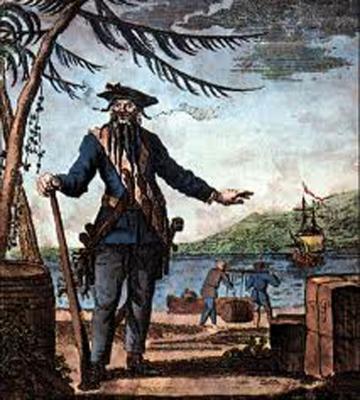
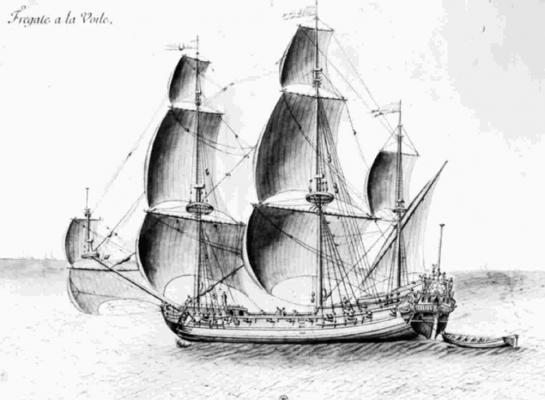
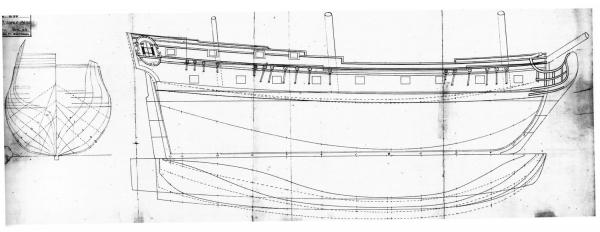
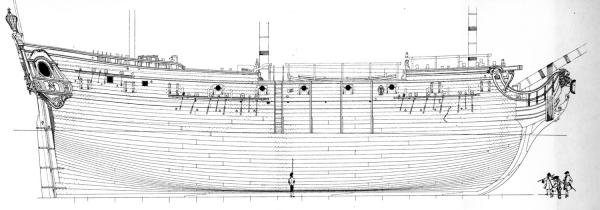
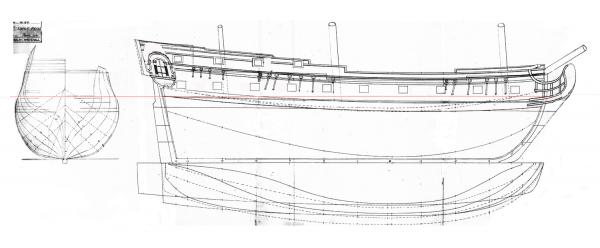
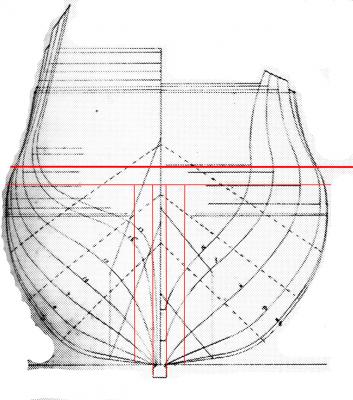
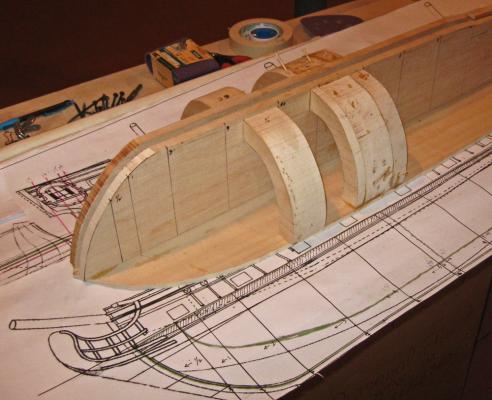
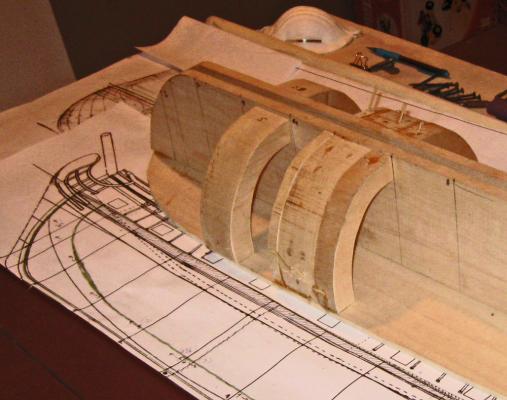
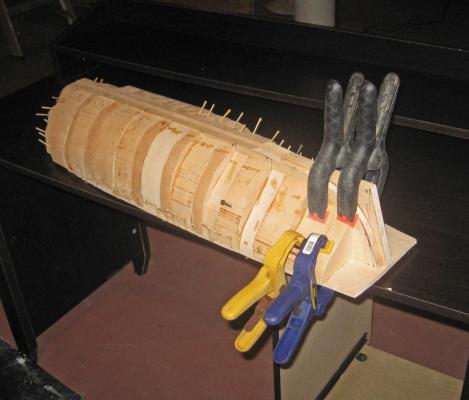
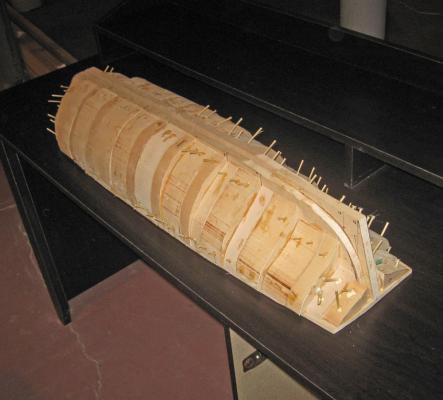

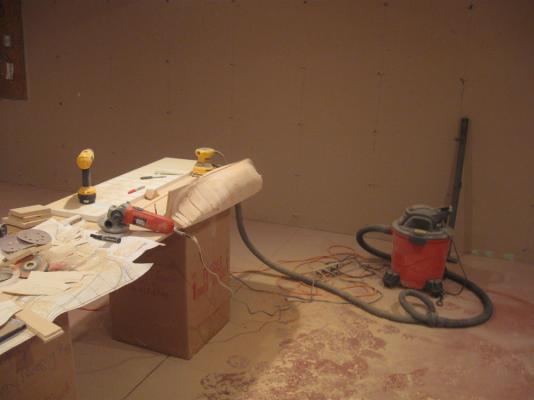
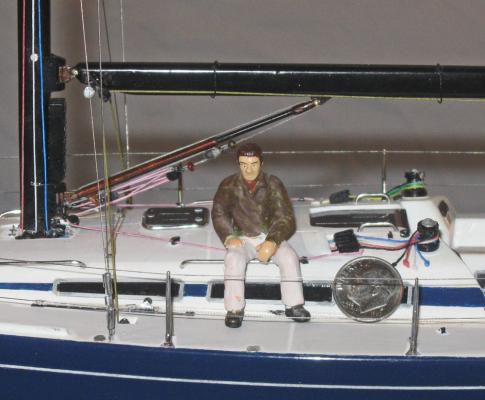
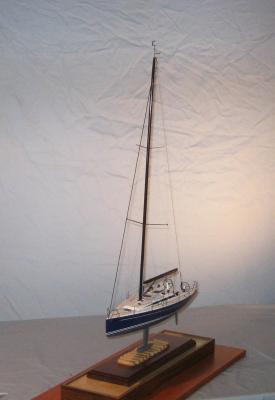
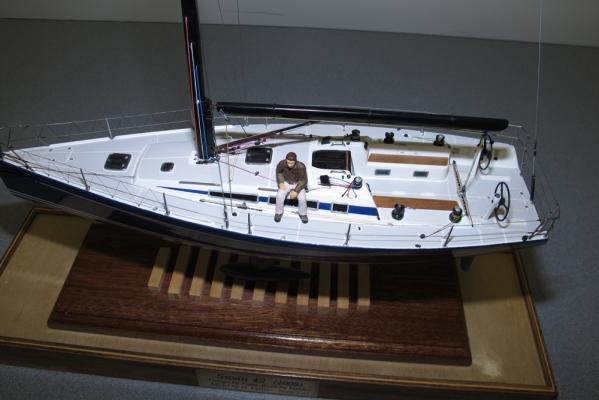
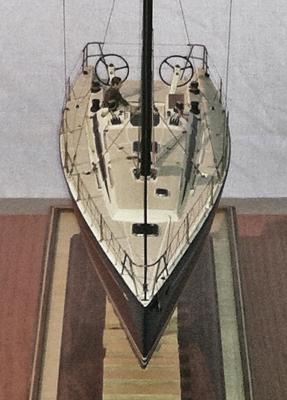
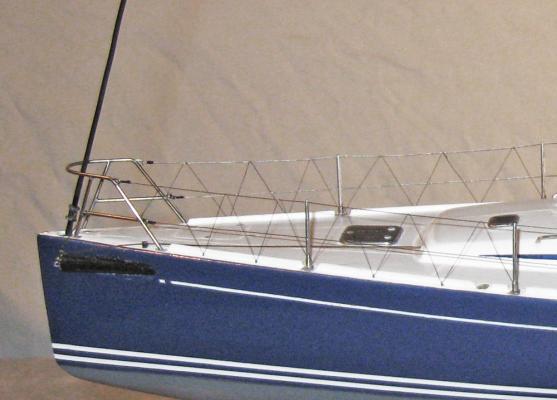
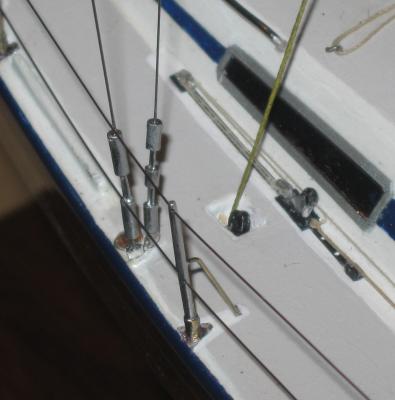

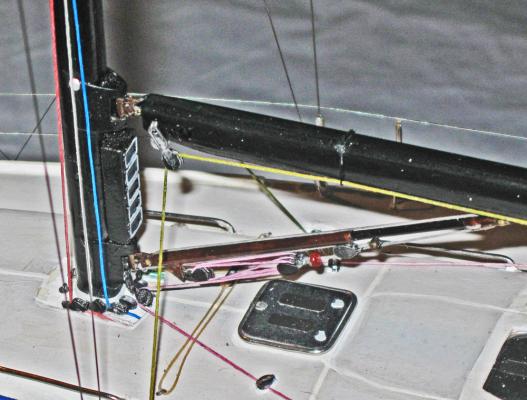
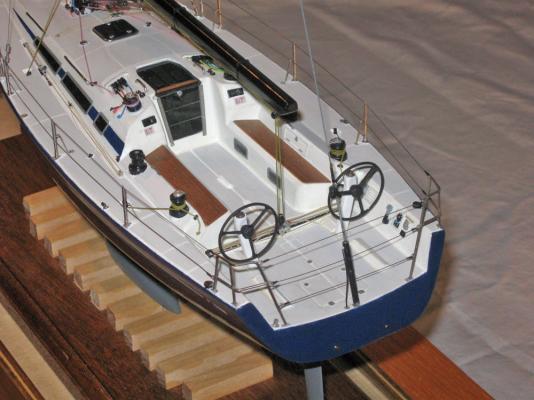
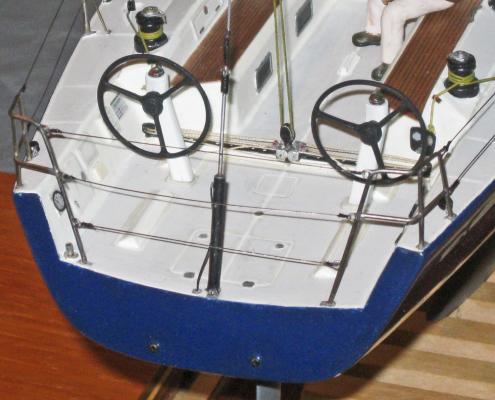
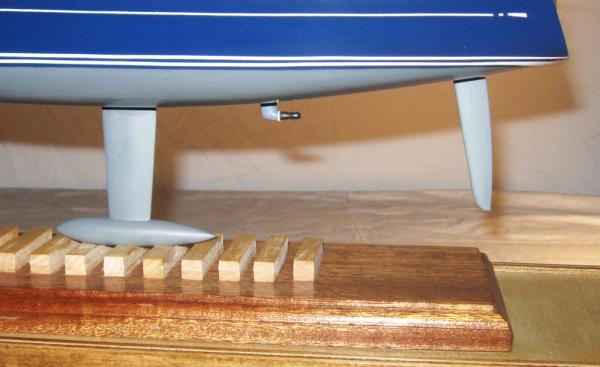
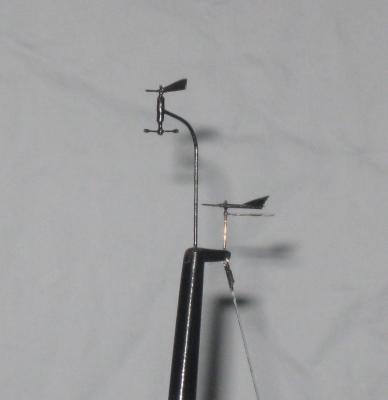
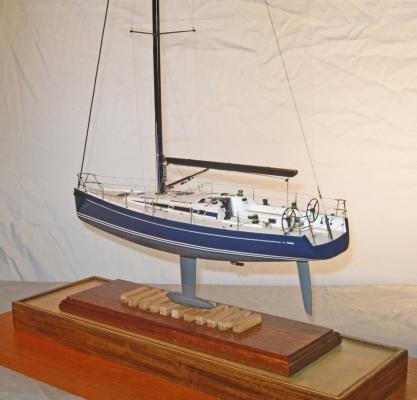
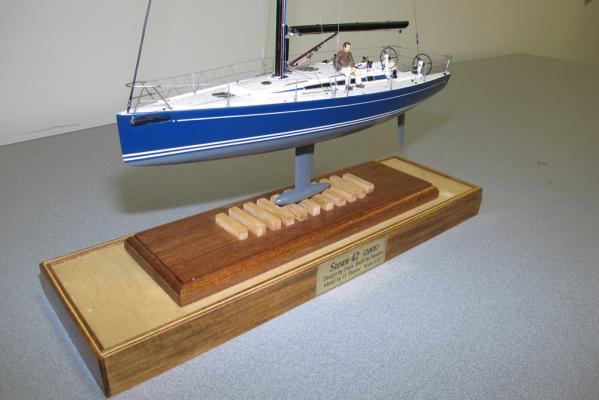
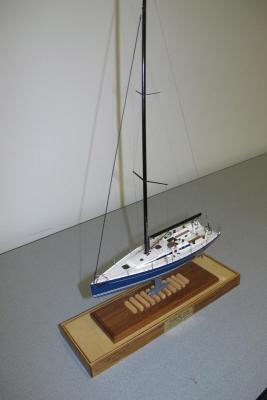
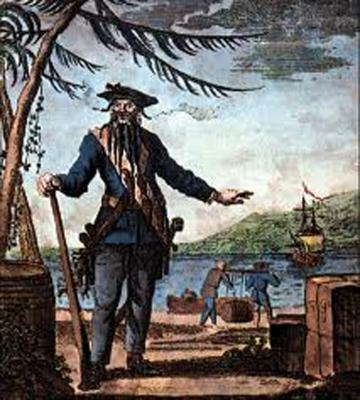
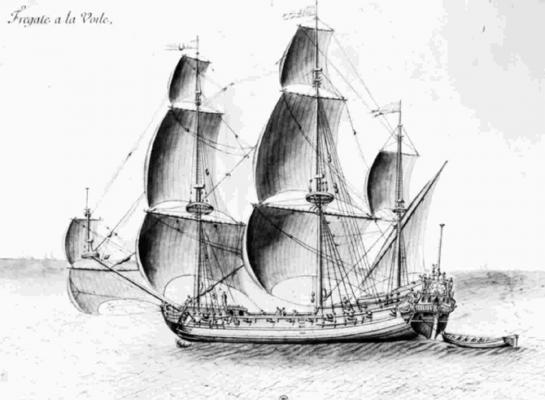
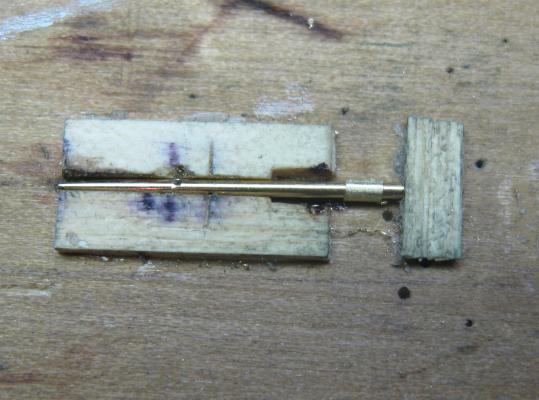













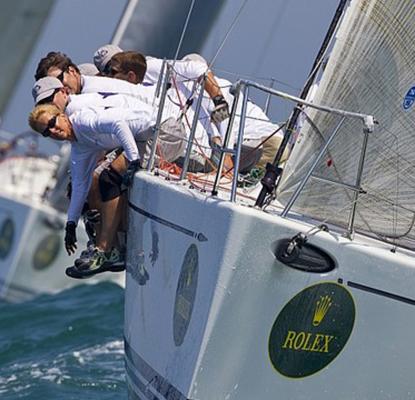
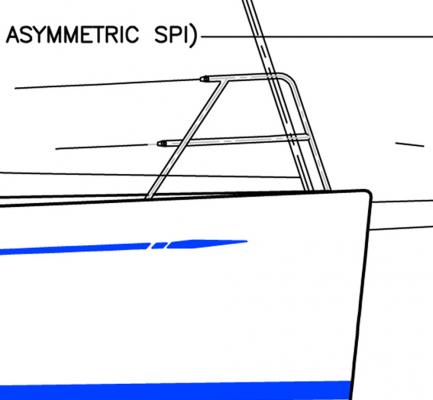
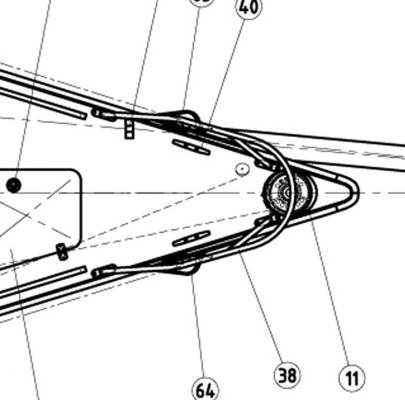
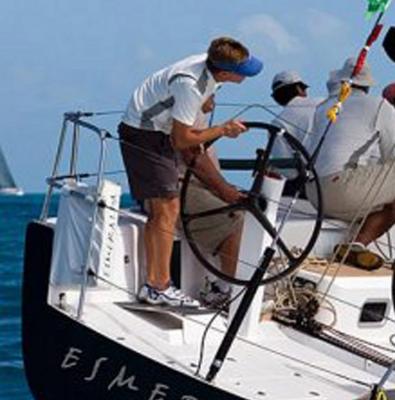
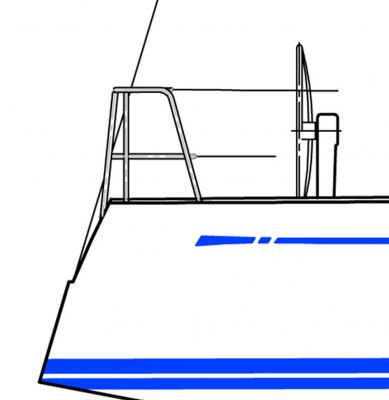
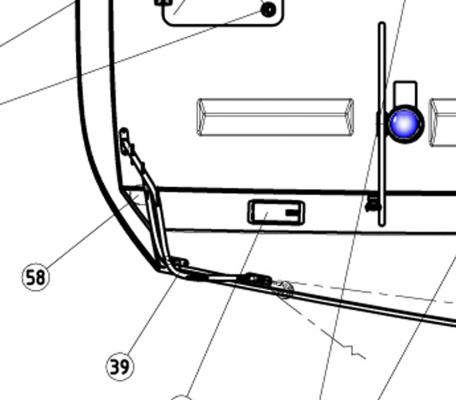
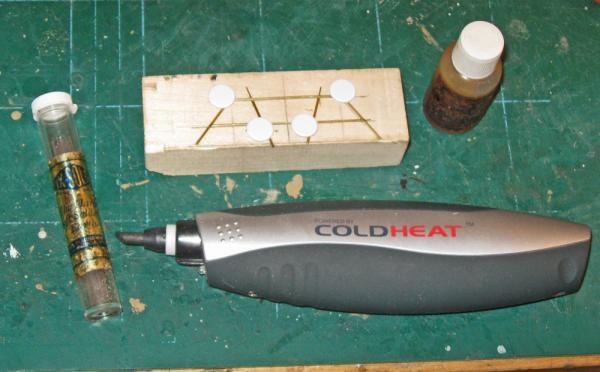
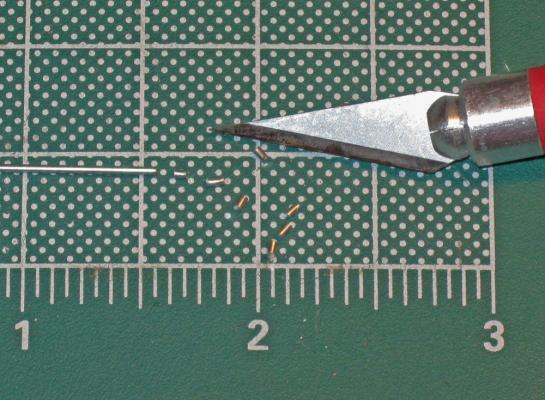
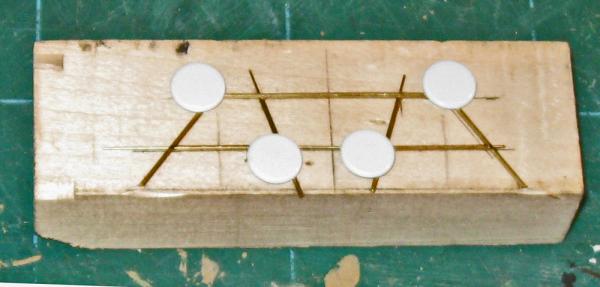
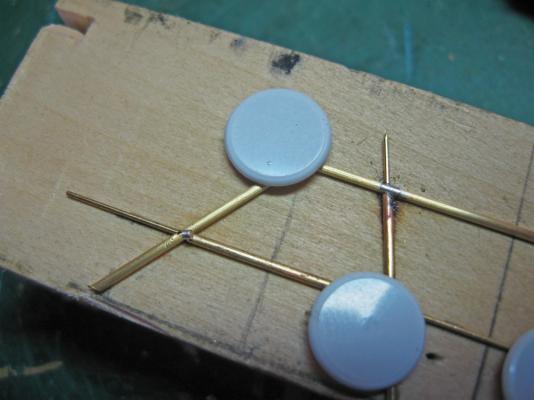
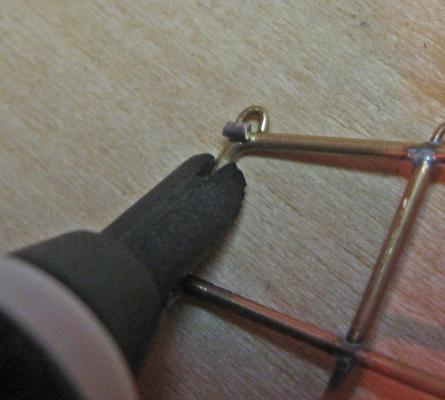
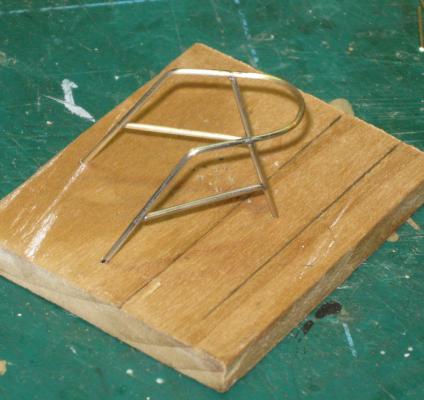
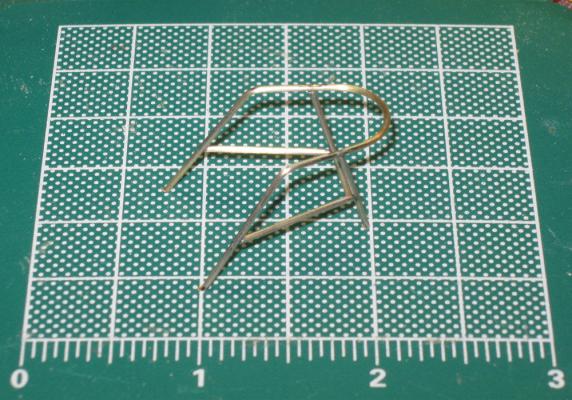
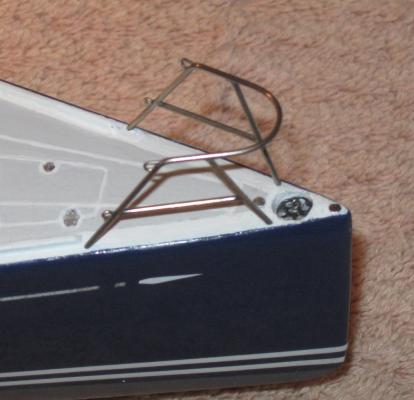
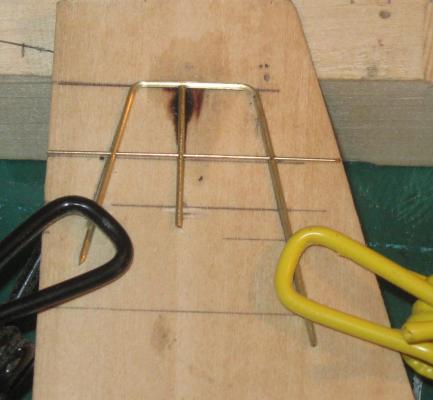
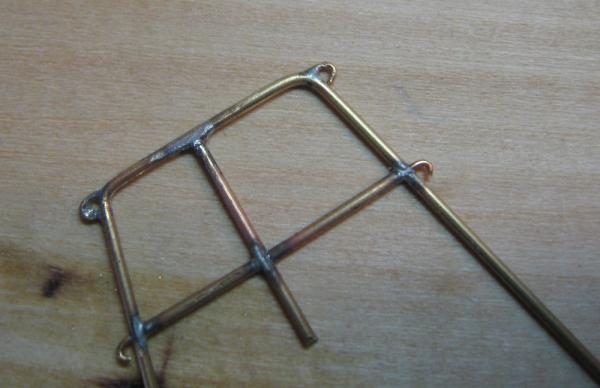
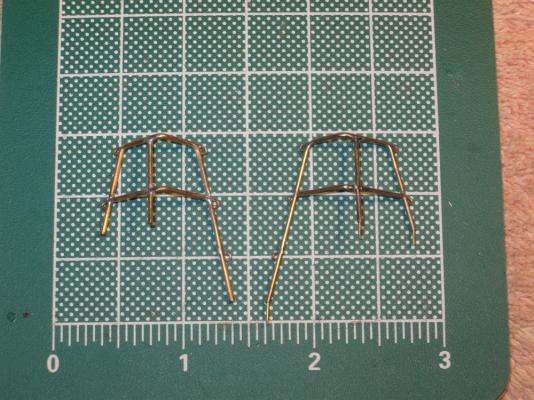
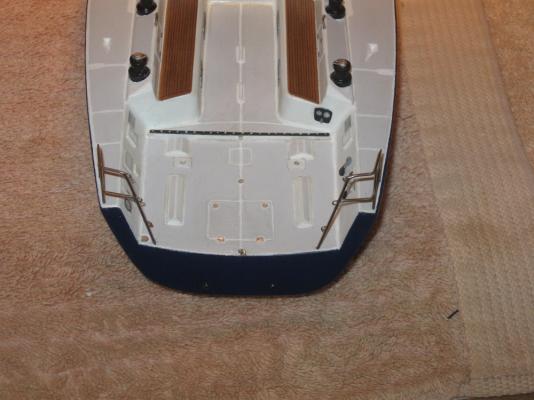
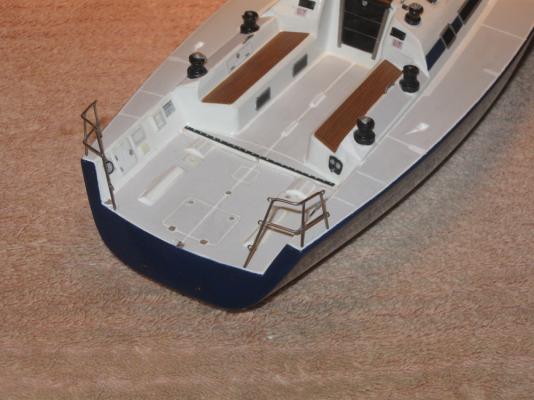
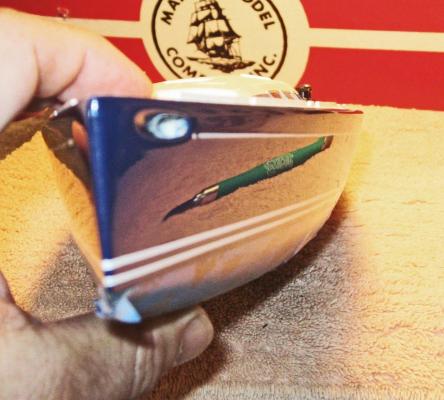
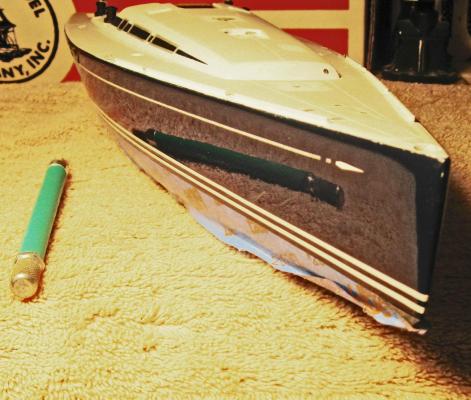
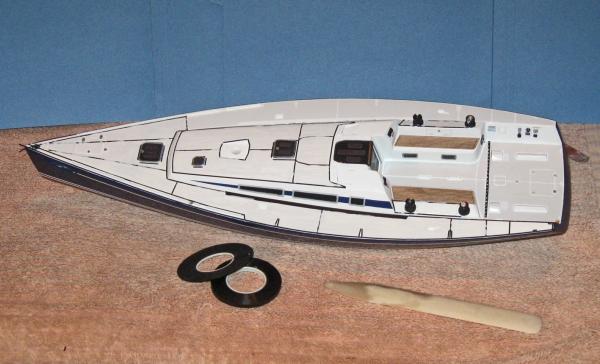
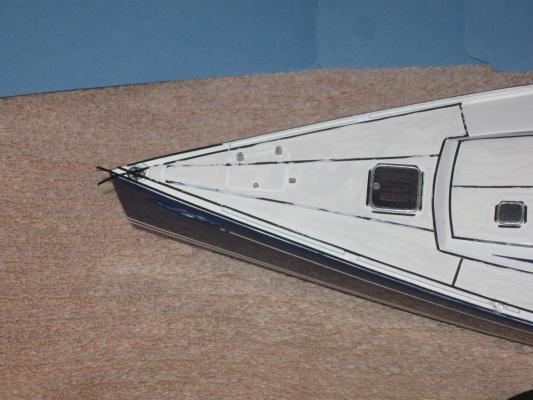

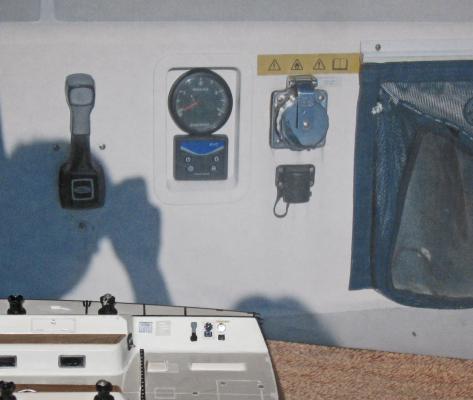
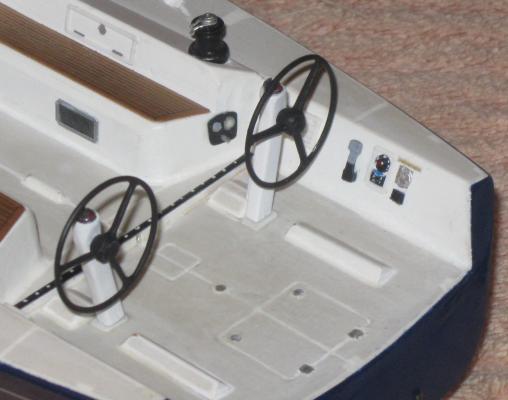
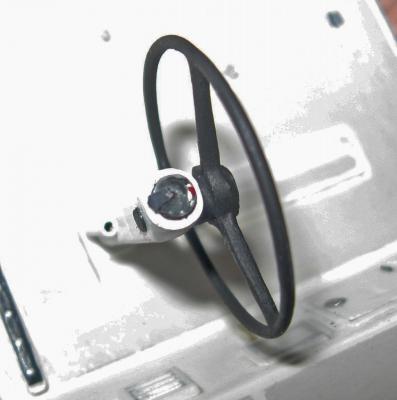
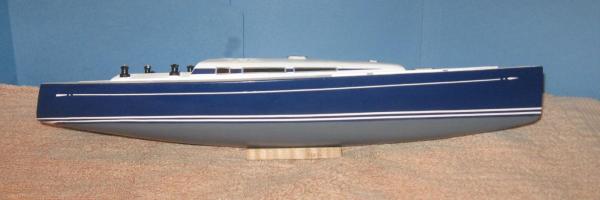
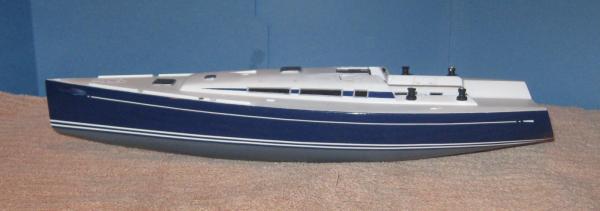
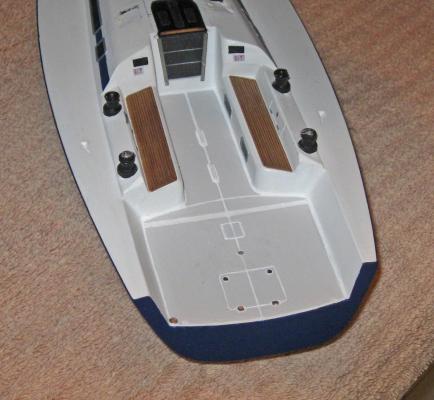
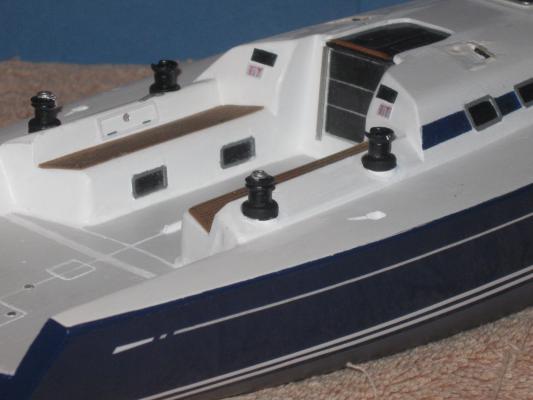
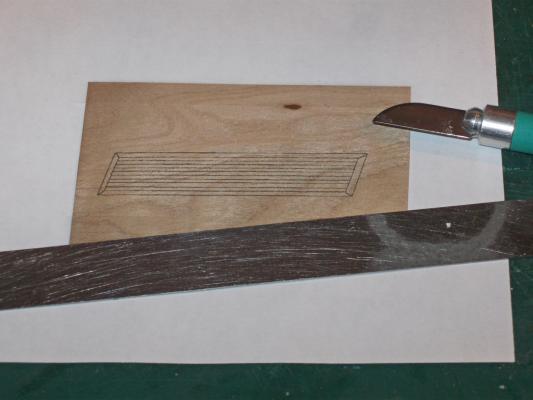
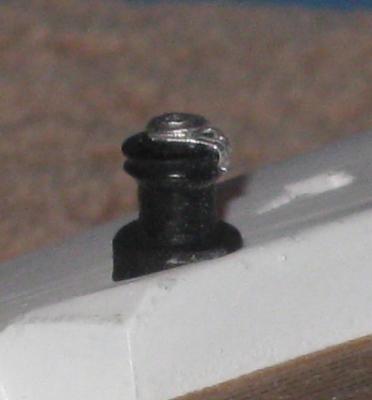
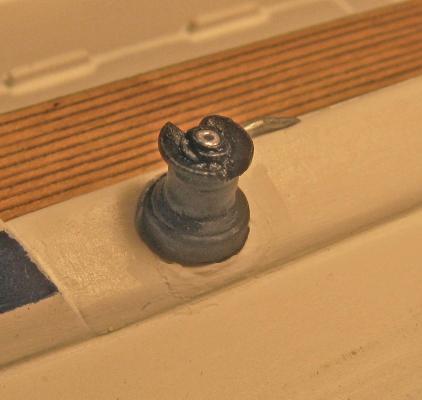
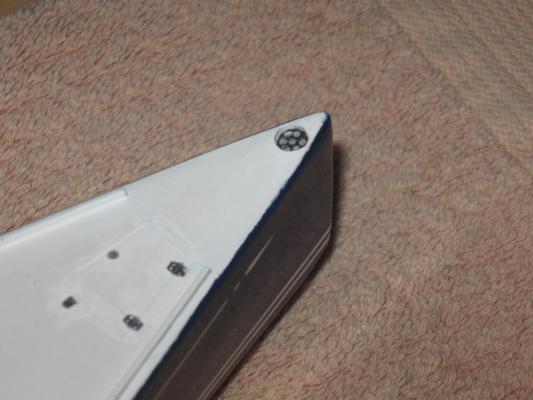
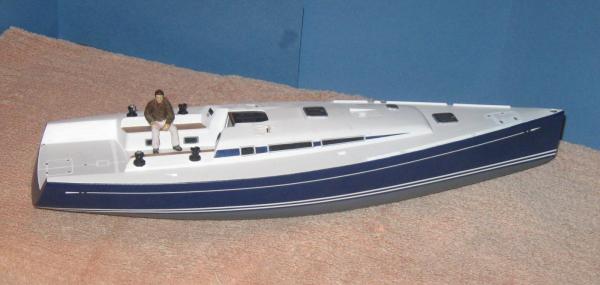
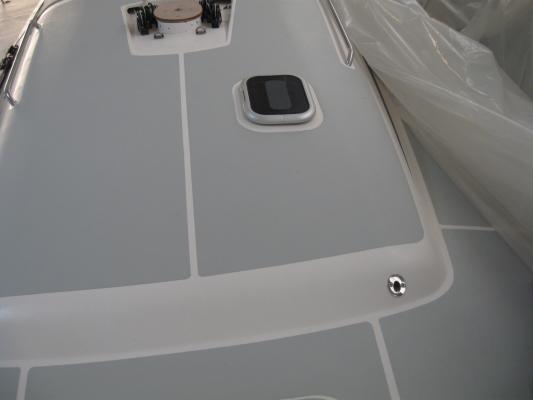
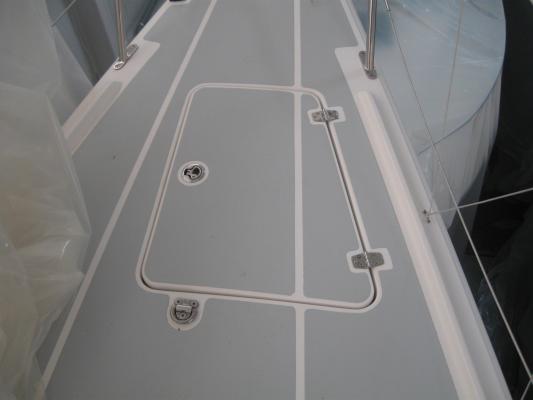
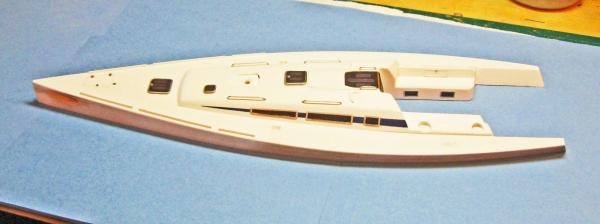
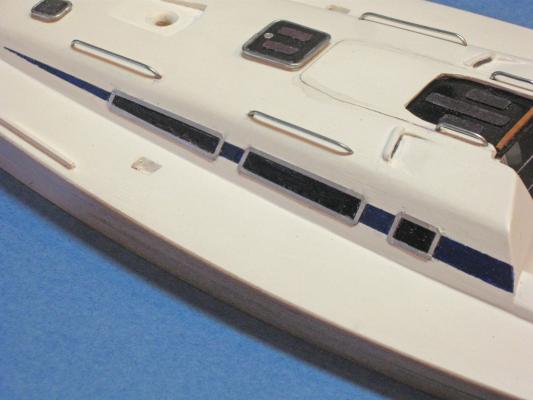
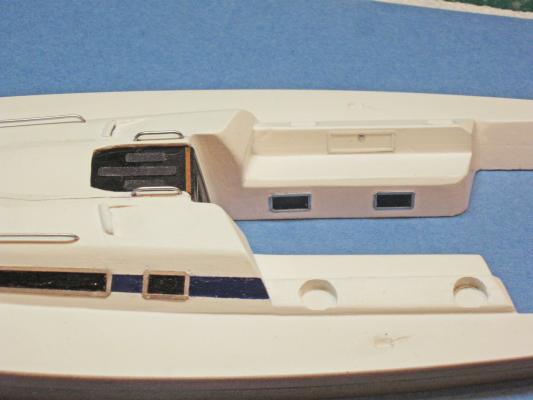
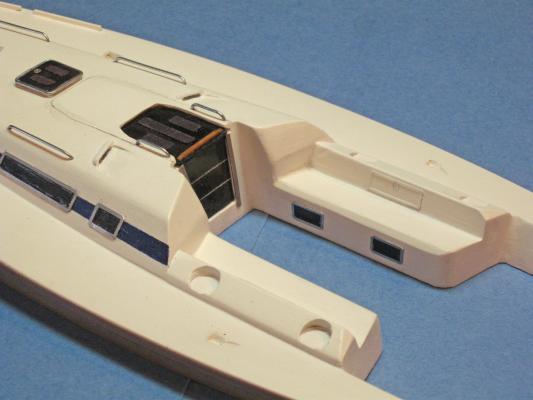
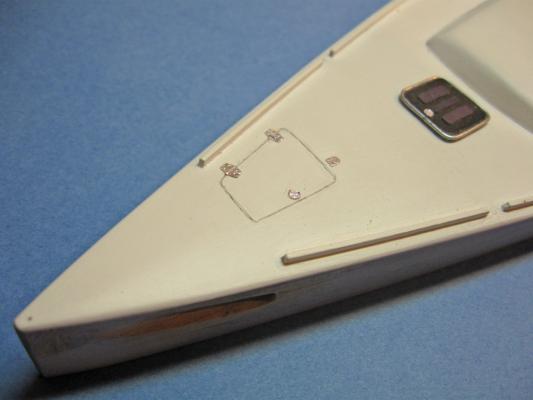

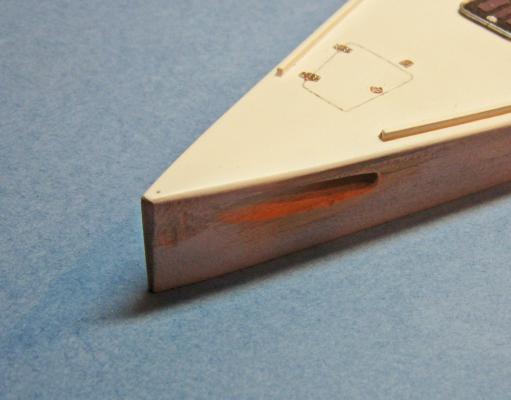
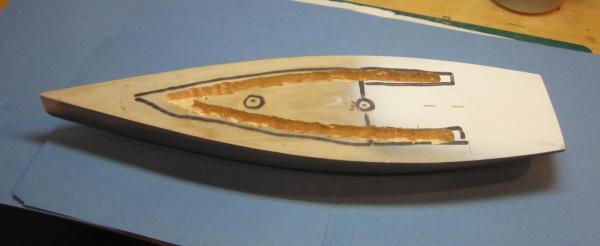
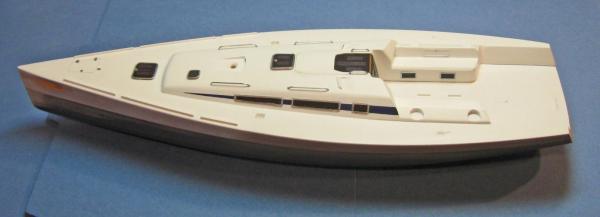
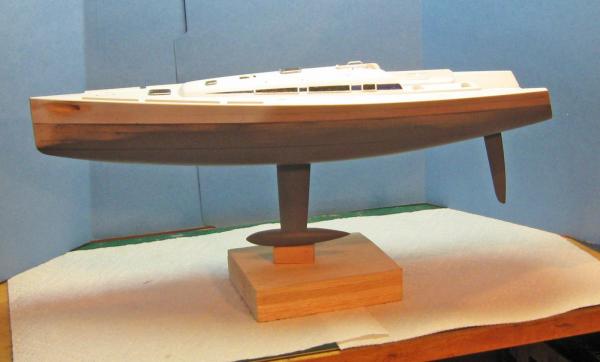

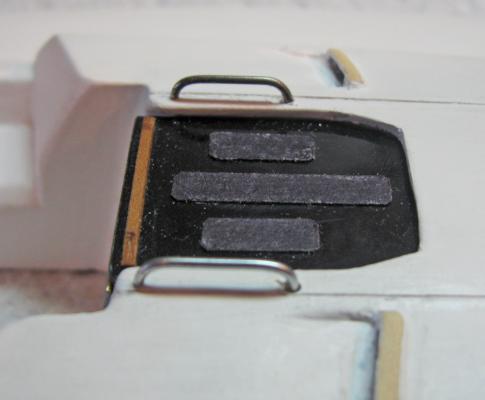
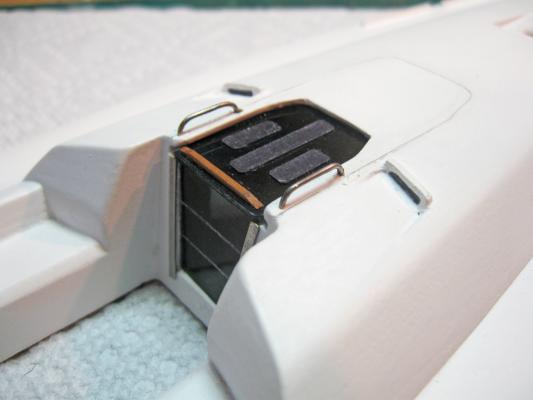

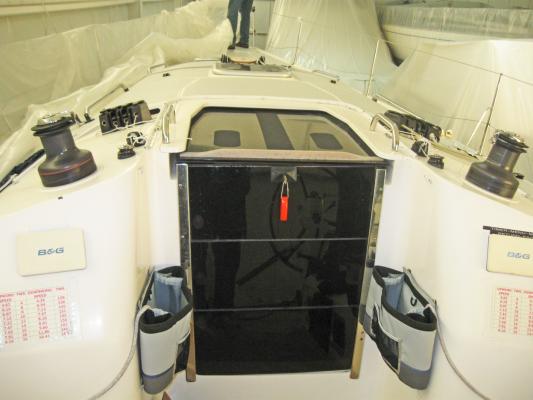
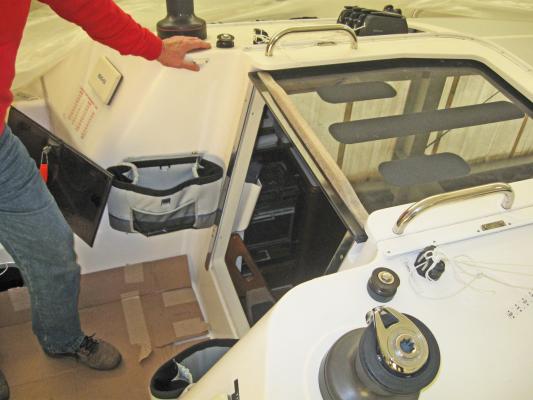
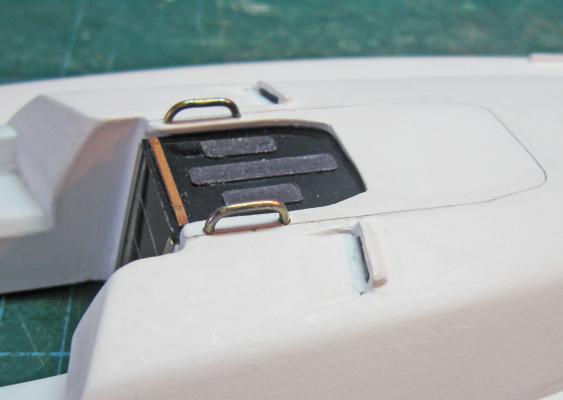
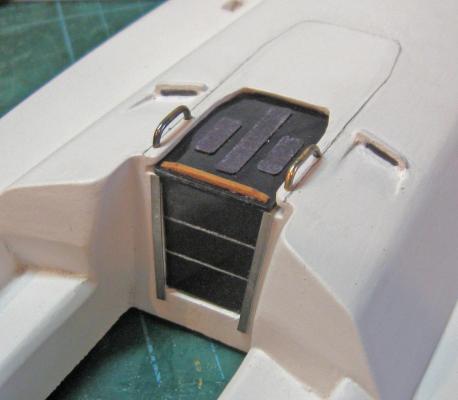
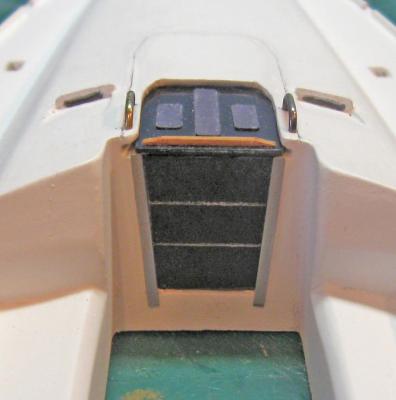
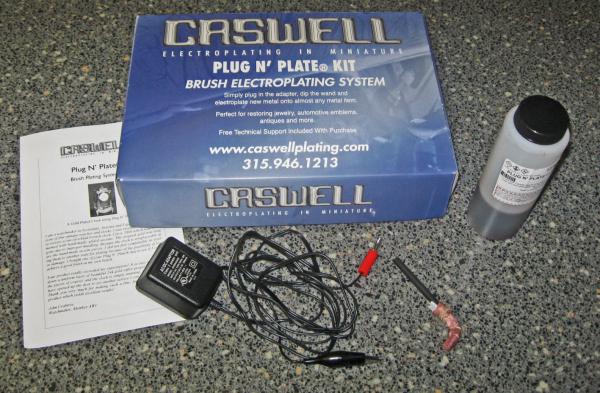
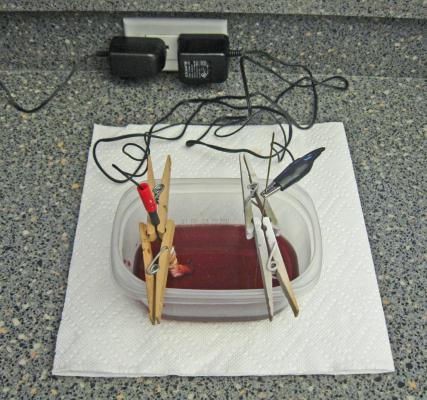
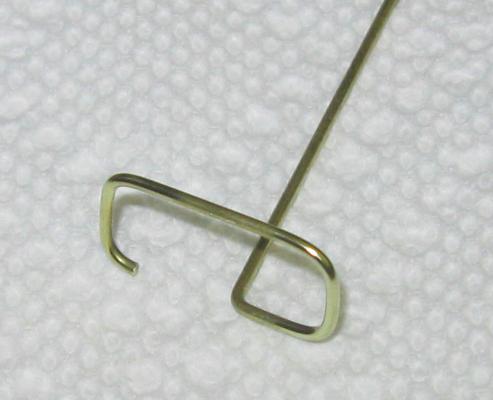
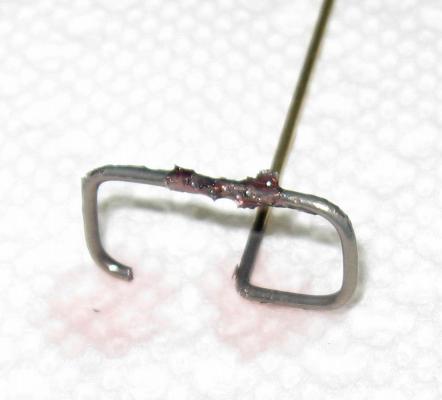
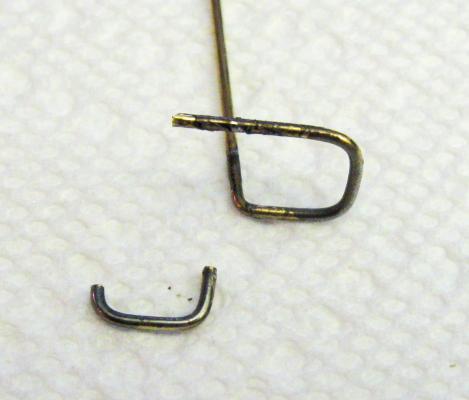
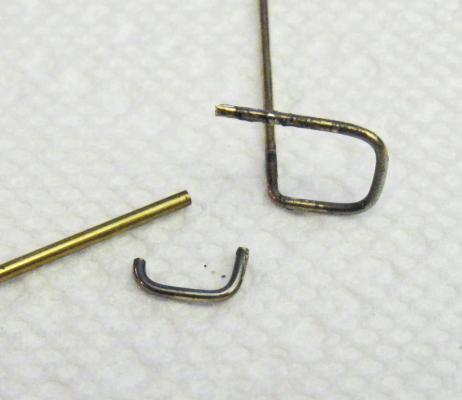
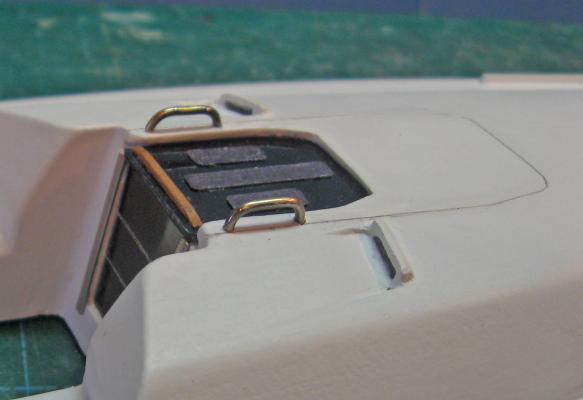
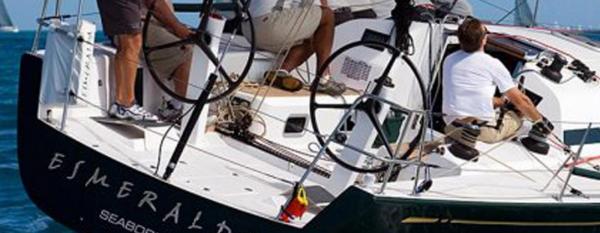
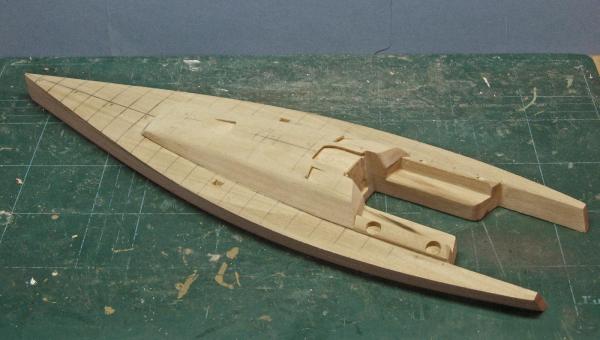
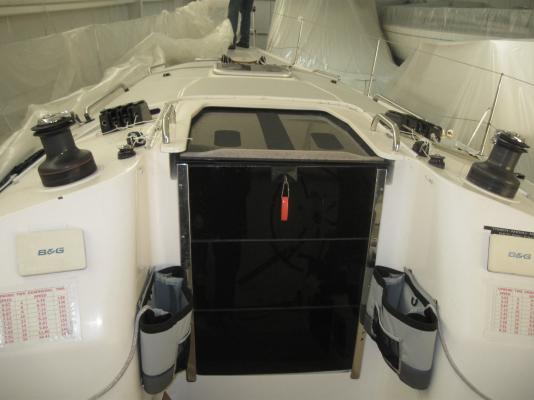
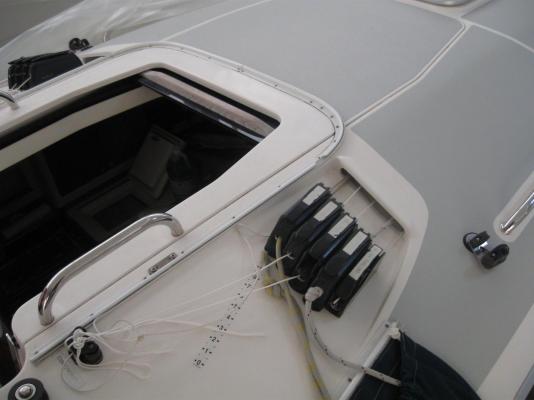
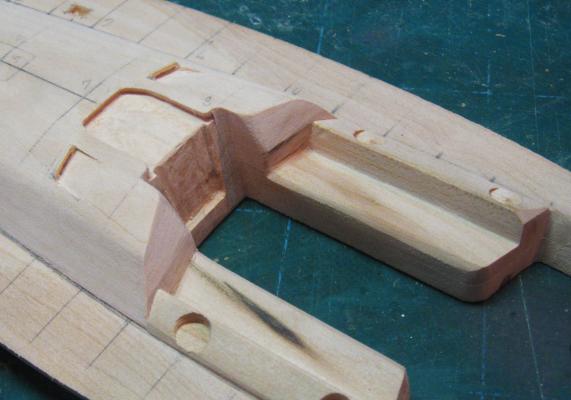
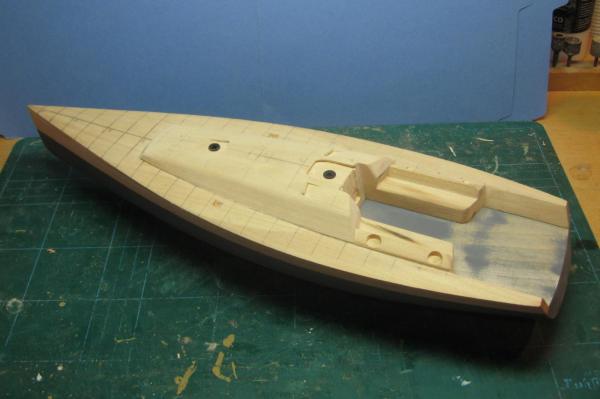
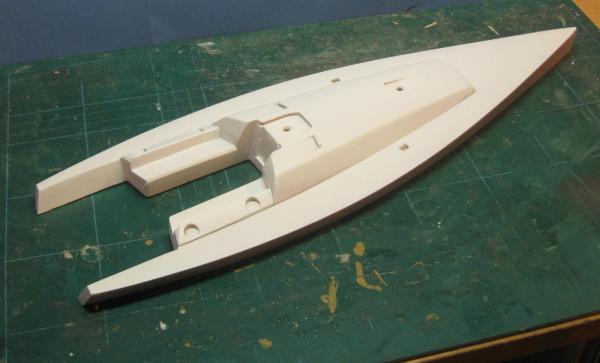
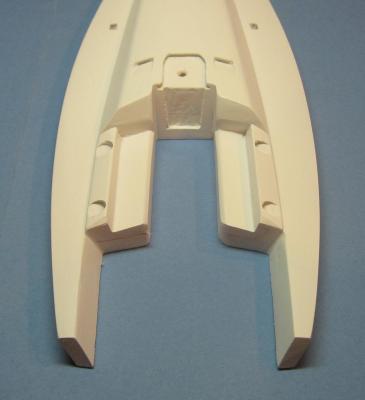
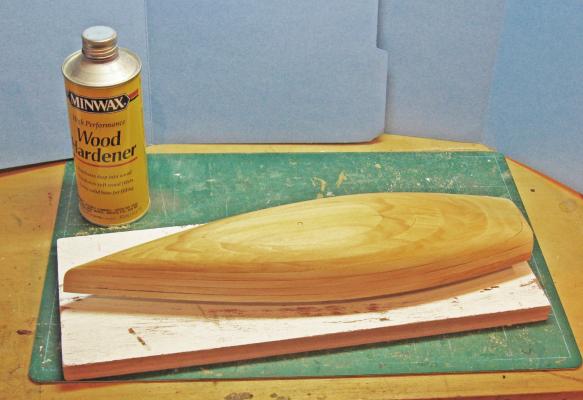
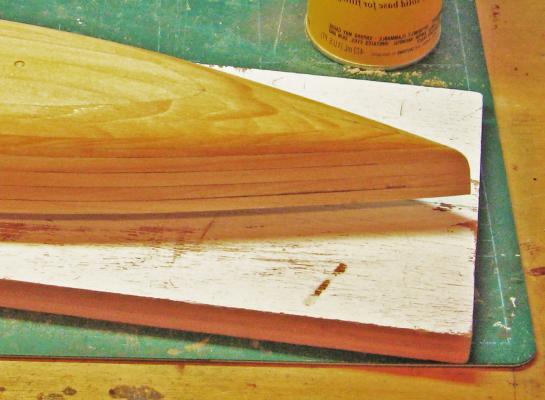
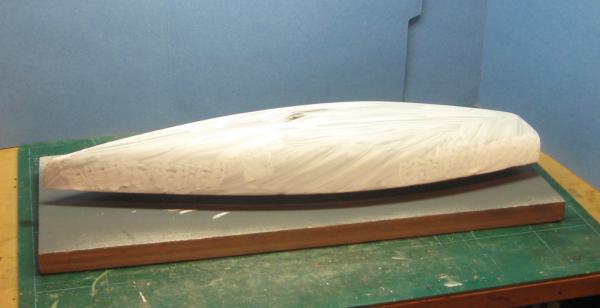
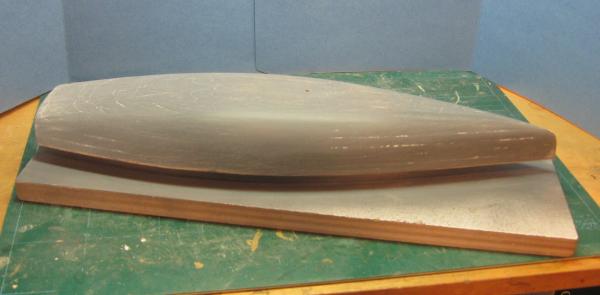
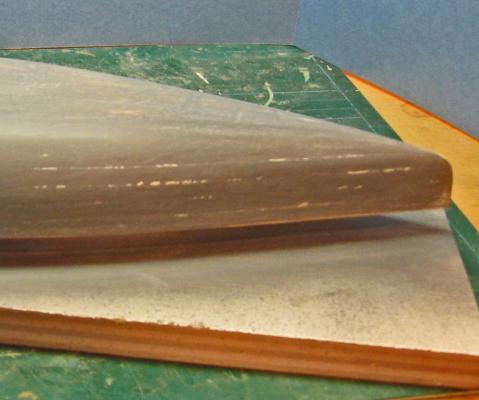
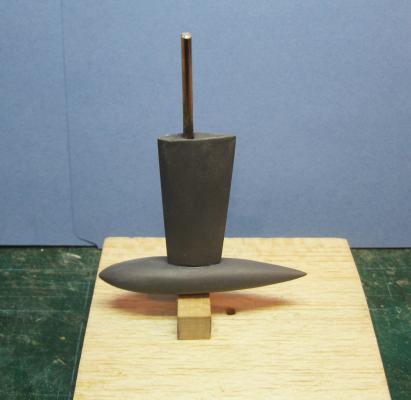
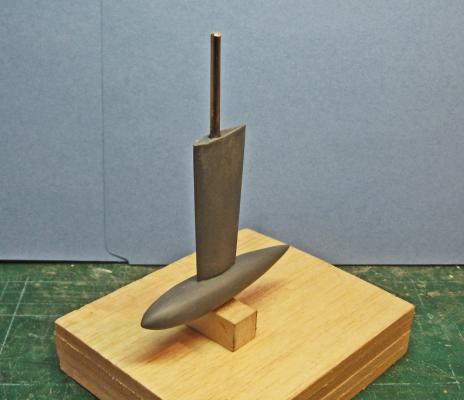
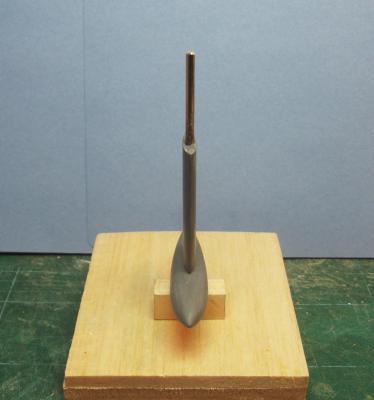
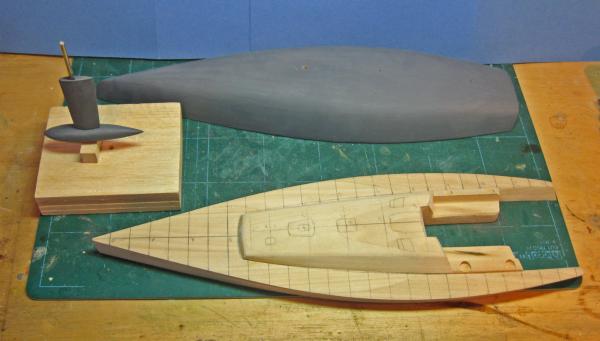
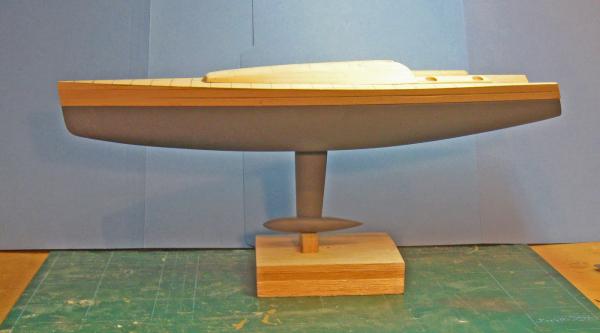
Queen Anne's Revenge 1710 by shipmodel - FINISHED - 1/36 scale
in - Build logs for subjects built 1501 - 1750
Posted · Edited by shipmodel
Good day to all -
This segment will be a bit of a detour from where I left the hull construction last time. The sheer size of the model means that I have to work on it in the basement of the family’s weekend house near Albany, NY. There is no way that I can fit it into the shipyard in the Brooklyn apartment, which is a converted walk-in closet. I haven’t been up to the house in several weeks, so I am working on smaller pieces here in the city that can be added later. The first of these are the ship’s boats. As always, there are half a dozen good ways to get the job done. Here is mine. The recitation is quite long, so I have broken it up into two parts. The first will cover the shaping and planking of the hull, and the second will finish with the fitting out of the interior.
The Mercure drawings that I am working from include plans and schematics for two boats, a large launch (boat 7) and a sleek pinnace (boat 6). Here I will be building the launch. The drawings had been sent to me as .tif files, so it was easy to drop them into Photoshop and start manipulating them.
First I used the rule stick in the hand of the little gnome dancing on the page to scale the drawing to the size of the model. I cropped and copied the forward and aft station lines portions of the plans and moved them to a new blank image. Identical square outlines were superimposed around the two drawings to give them the same registration planes and centerlines.
Once I was happy that everything was square and aligned correctly they were copied repeatedly to fill a page sized image and printed out several times to get one image for each of the 21 stations shown on the profile and cross section plans. These were cut apart and glued with spray mount to squares of 1/8” wood sheet.
The outline at each station was cut out with a notch for the keel and shoulders at the sheer. The three in the upper right are standing up because they have already had spacers glued to their back sides like the one in the upper left. These are used with the building board, which is marked out for the centerline and each numbered station.
The station formers are glued to the board and to each other one at a time with a top spacer used to keep them at the proper distance and an engineer’s square to see that they are perfectly vertical.
While the glue was drying on the developing stack of formers the two strongbacks (stem-keel-sternpost) were cut out. It is somewhat weaker to do it this way, as you end up with cross-grain on the stem and sternpost, but it is faster, and this boat is something of a test bed for techniques. For the same reason, the wood used is almost exclusively basswood. It is easy to work, glues well, and when stained correctly is almost impossible to distinguish from a close-grained hardwood.
The portion of the plans showing the longitudinal cross section was mounted on an 1/8” wood sheet which was then glued to a second sheet, with the glue placed only where the wood would be chucked. The outline of the strongback was cut out on the band saw, leaving a glued central piece to be cut last. This yielded two identical pieces that came apart as soon as the last cut was completed.
Here is the completed stack of formers on the building board with one of the strongbacks temporarily set up in the notch for the keel. It goes without saying that once the stack was fully glued it was shaped and faired with sanding rods to get smooth curves from bow to stern.
The strongback is held vertically with small blocks at the bow and stern that sandwich the tops at the centerline. Two transom pieces were taken from the plans, laid out and cut as before, and each was test fit into the notch cut for it at the base of the sternpost. The location of the forward edge of the plank rabbet was determined and marked out on the strongback, then the small extensions that had been left above the stem and sternpost were trimmed until it snuggled down into the keel notch at the proper level.
The strongback was removed and the rabbet was carved along the line with rotary bitts, then finished with files and rifflers. The transom was planked on the outside and glued in place against the sternpost.
Now I fit the ribs to the station formers. It was a happy fact that Budriot drew the boat with a rib at each station line and a station line at each rib. To make room for them I had cut out the station formers a little inside the line, and the sanding and fairing had further reduced the breadth of the stack. The ribs were fairly thin in any case, made from wood strips milled to 1mm x 2mm (about 1.5” x 3” in scale”). These were soaked in water to soften, then bent around each former and wired in place. No glue was used.
All of the ribs were wired in place except the aftmost one at Station 21. Leaving it off gave me a little more flexibility in fairing the planks to the transom. The strongback was replaced in the keel notch of the formers and the initial two planks were shaped.
The first was the sheer strake. From the plans it measured out to exactly ¼” in width and was left full width its entire length. A strip of basswood that width and 1/16” thick was soaked for a few minutes, then shaped first at the bow, where the tip was cut and angled to fit into the rabbet. The forward few inches were steam bent using an Amati plank bender (the one that looks like a soldering iron with a nautiloid shaped head). It is 25 years old and still works a treat. Using the shoulders cut into the formers at the sheer the plank was edge bent to match the curve before being clamped and glued to each rib and the transom.
The garboard strake against the keel was similarly fitted and glued. However, when I tried to impose the required twists into a basswood plank it repeatedly splintered. I therefore used pau marfim, a California hardwood. It is also ¼” wide for most of its length but flares to about twice that at the sternpost. To accommodate this, a tapered plank was pieced in from Station 15 to the sternpost. When I was happy with the look of the shape it was clamped and glued to the ribs. Here is what they looked like with most of the clamps removed.
A word here about stains and glues. Before any piece was installed it was given a staining with a mixture of ½ clear Minwax wood stain which they call Natural, ¼ Early American and ¼ Cherry. I find this combination the best to reduce any splotchiness in the basswood and makes basswood resemble boxwood or one of the lighter cherry varieties, a look that I like a lot. However, the stain is a bit oily, so the wood has to be well wiped and has to dry for a while before normal PVA glues will hold well.
As for glue, I use a pH neutral white glue made by Lineco which I used to get from an art conservation supply house. It sets up fast and holds well, yet is still flexible for an extended time, which will come in handy later. Now I get it through Amazon where it is competitively priced with carpenters’ wood glues.
This process was repeated for the second sheer plank and the first broad strake against the garboard, but these had to be tapered to fit at the bow. I knew from test fittings with strips of paper that there was almost exactly half the space between the garboard and sheer strake at the bow than there was between these planks amidships. Therefore the next two planks were tapered for their forward three inches to that dimension. Holding the plank to the formers and letting it find its own best fit, it was evident that the tapering on the second sheer strake should come off the edge that mated with the sheer strake, while the broad strake should taper on the garboard side.
After the bulk of the wood was removed the edge was sanded to a fair curve. This spiling was all done by eye, with the curve examined from every angle and refined as needed on this and every successive plank.
Once acceptably shaped the planks were stained, then caulking was indicated by coloring the uncut edge of the plank with an indelible black marker. The planks were bent to final shape, fitted, glued and clamped in place.
With two strakes at the keel and two at the sheer, the cage of ribs had a good deal of strength and rigidity. Now all of the wires were pulled out and the developing hull was removed from the formers. I must have done a clean job with the glue because I didn’t have to pry it loose at any point.
Subsequent strakes were processed in a similar way. For clamps I used bulldog clips that had a handle piece from a second clip fitted into the top of the clip. A modified clip was used on every other former to hold the plank to the ribs as the glue dried.
Here is what the hull looked like with 8 of the 11 strakes in place. At this point the remaining space was divided into thirds as you can see from the pencil marks on the ribs. This would be filled with two standard width planks and one custom fit ‘shutter plank’ that closed in the hull.
Here is one completed side. The shutter plank location was selected to lie just under the curve of the chine of the hull, making it less visible than any other spot. It is the fourth from the keel. It is slightly wider than the other planks and flares at the stern to fill the larger space.
While it was on the formers the location of each rib was penciled onto the planks in preparation for the ‘nails’ holding the planks to the ribs.
Once the other side was closed up the hull was removed from the formers. I think the method worked quite well and resulted in a hull that is strong, symmetric, and gives a convincing appearance of an actual boat structure. The white plastic figure in the corner is useful to judge scale appearance and will appear again.
Spiling the planking by eye in this way is an acquired skill, but not difficult if each plank is critically examined and adjusted as needed. The final hull has a nice run of planking that tapers smoothly to the stem and matches, port to starboard, and even has the little variations in width that a real boat does.
In the next installment I use the penciled lines to drill the nail holes for the more than 1100 fasteners used for the hull planks. Then I fit out the interior and finish the boat.
As always, critical review by the eyes of my peers is requested. This is even more so in this case since the boat is the first generation attempt and, despite the work and time invested, may not make the final cut.
Looking forward to hearing from all.
Dan